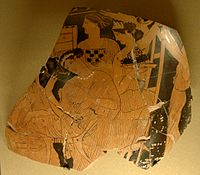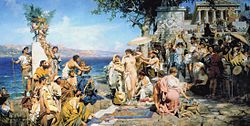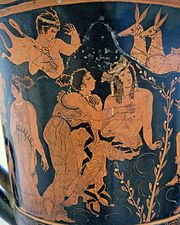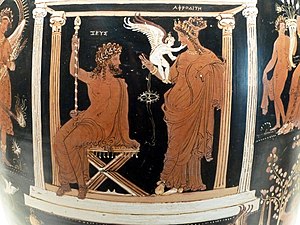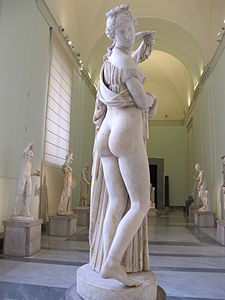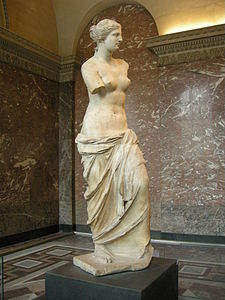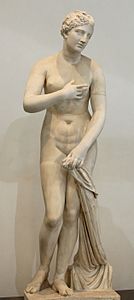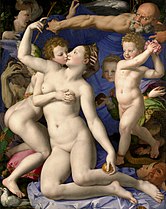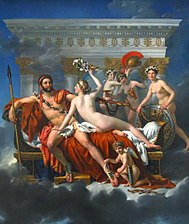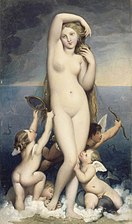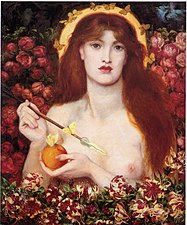Афродита
| Афродита | |
|---|---|
Богиня любви, похоти, страсти, удовольствия, красоты и сексуальности. | |
| Член двенадцати олимпийцев | |
 The Ludovisi Cnidian Aphrodite, Roman marble copy (torso and thighs) with restored head, arms, legs and drapery support | |
| Abode | Mount Olympus |
| Planet | Venus |
| Animals | dolphin, sparrow, dove, swan, hare, goose, bee, fish, butterfly |
| Symbol | rose, seashell, pearl, mirror, girdle, anemone, lettuce, narcissus |
| Tree | myrrh, myrtle, apple, pomegranate |
| Genealogy | |
| Parents | Zeus and Dione (Homer)[1] Uranus (Hesiod)[2] |
| Consort |
|
| Children | Eros, Phobos, Deimos, Harmonia, Pothos, Anteros, Himeros, Hermaphroditus, Rhodos, Eryx, Peitho, The Graces, Beroe, Golgos, Priapus, Aeneas |
| Equivalents | |
| Roman equivalent | Venus |
| Canaanite equivalent | Astarte |
| Mesopotamian equivalent | Inanna |
| Egyptian equivalent | Hathor, Isis |
Афродита ( / ˌ æ f r ə ˈ d aɪ t iː / , AF -re- DY -tee ) [ 3 ] — древнегреческая богиня, связанная с любовью , похотью , красотой , удовольствием , страстью , деторождением и, как ее синкретизированный аналог римской богини Венерой , желанием, сексом, плодородием , процветанием и победой. Основными символами Афродиты являются морские ракушки , мирты , розы , голуби , воробьи и лебеди . произошел от финикийской богини Астарты , родственной восточно -семитской богине Иштар , чей культ был основан на шумерском культе Инанны Культ Афродиты в значительной степени . Главными центрами культа Афродиты были Кифера , Кипр , Коринф и Афины . Ее главным фестивалем была Афродисия , которая отмечалась ежегодно в середине лета. В Лаконии Афродите поклонялись как богине-воительнице. Она также была богиней-покровительницей проституток , ассоциации, которая побудила первых ученых предложить концепцию « священной проституции » в греко-римской культуре, идею, которая сейчас обычно считается ошибочной.
In Hesiod's Theogony, Aphrodite is born off the coast of Cythera from the foam (ἀφρός, aphrós) produced by Uranus's genitals, which his son Cronus had severed and thrown into the sea. In Homer's Iliad, however, she is the daughter of Zeus and Dione. Plato, in his Symposium, asserts that these two origins actually belong to separate entities: Aphrodite Urania (a transcendent, "Heavenly" Aphrodite) and Aphrodite Pandemos (Aphrodite common to "all the people").[4] У Афродиты было много других эпитетов , каждый из которых подчеркивал разные аспекты одной и той же богини или использовался разными местными культами. Таким образом, она была также известна как Цитерия ( Госпожа Киферы ) и Киприда ( Госпожа Кипра ), потому что оба места претендовали на то, чтобы быть местом ее рождения.
In Greek mythology, Aphrodite was married to Hephaestus, the god of fire, blacksmiths and metalworking. Aphrodite was frequently unfaithful to him and had many lovers; in the Odyssey, she is caught in the act of adultery with Ares, the god of war. In the First Homeric Hymn to Aphrodite, she seduces the mortal shepherd Anchises. Aphrodite was also the surrogate mother and lover of the mortal shepherd Adonis, who was killed by a wild boar. Along with Athena and Hera, Aphrodite was one of the three goddesses whose feud resulted in the beginning of the Trojan War and she plays a major role throughout the Iliad. Aphrodite has been featured in Western art as a symbol of female beauty and has appeared in numerous works of Western literature. She is a major deity in modern Neopagan religions, including the Church of Aphrodite, Wicca, and Hellenismos.
Etymology
Hesiod derives Aphrodite from aphrós (ἀφρός) "sea-foam",[5] interpreting the name as "risen from the foam",[6][5] but most modern scholars regard this as a spurious folk etymology.[5][7] Early modern scholars of classical mythology attempted to argue that Aphrodite's name was of Greek or Indo-European origin, but these efforts have now been mostly abandoned.[7] Aphrodite's name is generally accepted to be of non-Greek (probably Semitic) origin, but its exact derivation cannot be determined with confidence.[7][8]
Scholars in the late nineteenth and early twentieth centuries, accepting Hesiod's "foam" etymology as genuine, analyzed the second part of Aphrodite's name as *-odítē "wanderer"[9] or *-dítē "bright".[10][11] More recently, Michael Janda, also accepting Hesiod's etymology, has argued in favor of the latter of these interpretations and claims the story of a birth from the foam as an Indo-European mytheme.[12][13] Similarly, Krzysztof Tomasz Witczak proposes an Indo-European compound *abʰor- "very" and *dʰei- "to shine", also referring to Eos,[14] and Daniel Kölligan has interpreted her name as "shining up from the mist/foam".[15] Other scholars have argued that these hypotheses are unlikely since Aphrodite's attributes are entirely different from those of both Eos and the Vedic deity Ushas.[16][17]
Modern scholars, due to the believed Near Eastern origins of Aphrodite's worship, have since proposed Semitic origins for the name.[8][18] Some scholars, such as Fritz Hommel, have suggested that Aphrodite's name is a hellenized pronunciation of the name Astarte; other scholars, however, reject this as being linguistically untenable.[19][20] Martin West reconstructs a Cyprian Canaanite form of the name as either *ʿAprodît or *ʿAproḏît, and cautiously suggests the latter as being an epithet with the meaning "She of the Villages".[21] Aren Wilson-Wright suggests the Phoenician form *ʾAprodīt as an elative epithet meaning "unique, excellent, sublime".[22]
A number of improbable non-Greek etymologies have also been suggested. One Semitic etymology compares Aphrodite to the Assyrian barīrītu, the name of a female demon that appears in Middle Babylonian and Late Babylonian texts.[23] Hammarström[24] looks to Etruscan, comparing (e)prθni "lord", an Etruscan honorific loaned into Greek as πρύτανις.[25][8][26] This would make the theonym in origin an honorific, "the lady".[25][8] Most scholars reject this etymology as implausible,[25][8][26] especially since Aphrodite actually appears in Etruscan in the borrowed form Apru (from Greek Aphrō, clipped form of Aphrodite).[8] The medieval Etymologicum Magnum (c. 1150) offers a highly contrived etymology, deriving Aphrodite from the compound habrodíaitos (ἁβροδίαιτος), "she who lives delicately", from habrós and díaita. The alteration from b to ph is explained as a "familiar" characteristic of Greek "obvious from the Macedonians".[27]
In the Cypriot syllabary, a syllabic script used on the island of Cyprus from the eleventh until the fourth century BC, her name is attested in the forms 𐠀𐠡𐠦𐠭𐠃𐠂 (a-po-ro-ta-o-i, read right-to-left),[28] 𐠀𐠡𐠦𐠯𐠭𐠂 (a-po-ro-ti-ta-i, samewise),[29] and finally 𐠀𐠡𐠦𐠯𐠪𐠈 (a-po-ro-ti-si-jo, "Aphrodisian", "related to Aphrodite", in the context of a month).[30]
Origins
Near Eastern love goddess
The cult of Aphrodite in Greece was imported from, or at least influenced by, the cult of Astarte in Phoenicia,[31][32][33][34] which, in turn, was influenced by the cult of the Mesopotamian goddess known as "Ishtar" to the East Semitic peoples and as "Inanna" to the Sumerians.[35][33][34] Pausanias states that the first to establish a cult of Aphrodite were the Assyrians, followed by the Paphians of Cyprus and then the Phoenicians at Ascalon. The Phoenicians, in turn, taught her worship to the people of Cythera.[36]
Aphrodite took on Inanna-Ishtar's associations with sexuality and procreation.[37] Furthermore, she was known as Ourania (Οὐρανία), which means "heavenly",[38] a title corresponding to Inanna's role as the Queen of Heaven.[38][39] Early artistic and literary portrayals of Aphrodite are extremely similar on Inanna-Ishtar.[37] Like Inanna-Ishtar, Aphrodite was also a warrior goddess;[37][32][40] the second-century AD Greek geographer Pausanias records that, in Sparta, Aphrodite was worshipped as Aphrodite Areia, which means "warlike".[41][42] He also mentions that Aphrodite's most ancient cult statues in Sparta and on Cythera showed her bearing arms.[41][42][43][37] Modern scholars note that Aphrodite's warrior-goddess aspects appear in the oldest strata of her worship[44] and see it as an indication of her Near Eastern origins.[44][45]
Nineteenth-century classical scholars had a general aversion to the idea that ancient Greek religion was at all influenced by the cultures of the Near East,[46] but, even Friedrich Gottlieb Welcker, who argued that Near Eastern influence on Greek culture was largely confined to material culture,[46] admitted that Aphrodite was clearly of Phoenician origin.[46] The significant influence of Near Eastern culture on early Greek religion in general, and on the cult of Aphrodite in particular,[47] is now widely recognized as dating to a period of orientalization during the eighth century BC,[47] when archaic Greece was on the fringes of the Neo-Assyrian Empire.[48]
Indo-European dawn goddess
Some early comparative mythologists opposed to the idea of a Near Eastern origin argued that Aphrodite originated as an aspect of the Greek dawn goddess Eos[49][50] and that she was therefore ultimately derived from the Proto-Indo-European dawn goddess *Haéusōs (properly Greek Eos, Latin Aurora, Sanskrit Ushas).[49][50] Most modern scholars have now rejected the notion of a purely Indo-European Aphrodite,[7][51][17][52] but it is possible that Aphrodite, originally a Semitic deity, may have been influenced by the Indo-European dawn goddess.[52] Both Aphrodite and Eos were known for their erotic beauty and aggressive sexuality[50] and both had relationships with mortal lovers.[50] Both goddesses were associated with the colors red, white, and gold.[50] Michael Janda etymologizes Aphrodite's name as an epithet of Eos meaning "she who rises from the foam [of the ocean]"[13] and points to Hesiod's Theogony account of Aphrodite's birth as an archaic reflex of Indo-European myth.[13] Aphrodite rising out of the waters after Cronus defeats Uranus as a mytheme would then be directly cognate to the Rigvedic myth of Indra defeating Vrtra, liberating Ushas.[12][13] Another key similarity between Aphrodite and the Indo-European dawn goddess is her close kinship to the Greek sky deity,[52] since both of the main claimants to her paternity (Zeus and Uranus) are sky deities.[53]
Forms and epithets
Aphrodite's most common cultic epithet was Ourania, meaning "heavenly",[57][58] but this epithet almost never occurs in literary texts, indicating a purely cultic significance.[59] Another common name for Aphrodite was Pandemos ("For All the Folk").[60] In her role as Aphrodite Pandemos, Aphrodite was associated with Peithō (Πείθω), meaning "persuasion",[61] and could be prayed to for aid in seduction.[61] The character of Pausanias in Plato's Symposium, takes differing cult-practices associated with different epithets of the goddess to claim that Ourania and Pandemos are, in fact, separate goddesses. He asserts that Aphrodite Ourania is the celestial Aphrodite, born from the sea foam after Cronus castrated Uranus, and the older of the two goddesses. According to the Symposium, Aphrodite Ourania is the inspiration of male homosexual desire, specifically the ephebic eros, and pederasty. Aphrodite Pandemos, by contrast, is the younger of the two goddesses: the common Aphrodite, born from the union of Zeus and Dione, and the inspiration of heterosexual desire and sexual promiscuity, the "lesser" of the two loves.[62][63] Paphian (Παφία), was one of her epithets, after the Paphos in Cyprus where she had emerged from the sea at her birth.[64]
Among the Neoplatonists and, later, their Christian interpreters, Ourania is associated with spiritual love, and Pandemos with physical love (desire). A representation of Ourania with her foot resting on a tortoise came to be seen as emblematic of discretion in conjugal love; it was the subject of a chryselephantine sculpture by Phidias for Elis, known only from a parenthetical comment by the geographer Pausanias.[65]
One of Aphrodite's most common literary epithets is Philommeidḗs (φιλομμειδής),[66] which means "smile-loving",[66] but is sometimes mistranslated as "laughter-loving".[66] This epithet occurs throughout both of the Homeric epics and the First Homeric Hymn to Aphrodite.[66] Hesiod references it once in his Theogony in the context of Aphrodite's birth,[67] but interprets it as "genital-loving" rather than "smile-loving".[67] Monica Cyrino notes that the epithet may relate to the fact that, in many artistic depictions of Aphrodite, she is shown smiling.[67] Other common literary epithets are Cypris and Cythereia,[68] which derive from her associations with the islands of Cyprus and Cythera respectively.[68]
On Cyprus, Aphrodite was sometimes called Eleemon ("the merciful").[58] In Athens, she was known as Aphrodite en kopois ("Aphrodite of the Gardens").[58] At Cape Colias, a town along the Attic coast, she was venerated as Genetyllis "Mother".[58] The Spartans worshipped her as Potnia "Mistress", Enoplios "Armed", Morpho "Shapely", Ambologera "She who Postpones Old Age".[58] Across the Greek world, she was known under epithets such as Melainis "Black One", Skotia "Dark One", Androphonos "Killer of Men", Anosia "Unholy", and Tymborychos "Gravedigger",[56] all of which indicate her darker, more violent nature.[56]
She had the epithet Automata because, according to Servius, she was the source of spontaneous love.[69]
A male version of Aphrodite known as Aphroditus was worshipped in the city of Amathus on Cyprus.[54][55][56] Aphroditus was depicted with the figure and dress of a woman, but had a beard, and was shown lifting his dress to reveal an erect phallus.[54][55] This gesture was believed to be an apotropaic symbol, and was thought to convey good fortune upon the viewer.[70] Eventually, the popularity of Aphroditus waned as the mainstream, fully feminine version of Aphrodite became more popular, but traces of his cult are preserved in the later legends of Hermaphroditus.[55]
Worship
Classical period
| Part of a series on |
| Ancient Greek religion |
|---|
 |

Aphrodite's main festival, the Aphrodisia, was celebrated across Greece, but particularly in Athens and Corinth. In Athens, the Aphrodisia was celebrated on the fourth day of the month of Hekatombaion in honor of Aphrodite's role in the unification of Attica.[71][72] During this festival, the priests of Aphrodite would purify the temple of Aphrodite Pandemos on the southwestern slope of the Acropolis with the blood of a sacrificed dove.[73] Next, the altars would be anointed[73] and the cult statues of Aphrodite Pandemos and Peitho would be escorted in a majestic procession to a place where they would be ritually bathed.[74] Aphrodite was also honored in Athens as part of the Arrhephoria festival.[75] The fourth day of every month was sacred to Aphrodite.[76]
Pausanias records that, in Sparta, Aphrodite was worshipped as Aphrodite Areia, which means "warlike".[41][42] This epithet stresses Aphrodite's connections to Ares, with whom she had extramarital relations.[41][42] Pausanias also records that, in Sparta[41][42] and on Cythera, a number of extremely ancient cult statues of Aphrodite portrayed her bearing arms.[43][58] Other cult statues showed her bound in chains.[58]
Aphrodite was the patron goddess of prostitutes of all varieties,[77][58] ranging from pornai (cheap street prostitutes typically owned as slaves by wealthy pimps) to hetairai (expensive, well-educated hired companions, who were usually self-employed and sometimes provided sex to their customers).[78] The city of Corinth was renowned throughout the ancient world for its many hetairai,[79] who had a widespread reputation for being among the most skilled, but also the most expensive, prostitutes in the Greek world.[79] Corinth also had a major temple to Aphrodite located on the Acrocorinth[79] and was one of the main centers of her cult.[79] Records of numerous dedications to Aphrodite made by successful courtesans have survived in poems and in pottery inscriptions.[78] References to Aphrodite in association with prostitution are found in Corinth as well as on the islands of Cyprus, Cythera, and Sicily.[80] Aphrodite's Mesopotamian precursor Inanna-Ishtar was also closely associated with prostitution.[81][82][80]
Scholars in the nineteenth and twentieth centuries believed that the cult of Aphrodite may have involved ritual prostitution,[82][80] an assumption based on ambiguous passages in certain ancient texts, particularly a fragment of a skolion by the Boeotian poet Pindar,[83] which mentions prostitutes in Corinth in association with Aphrodite.[83] Modern scholars now dismiss the notion of ritual prostitution in Greece as a "historiographic myth" with no factual basis.[84]
Hellenistic and Roman periods
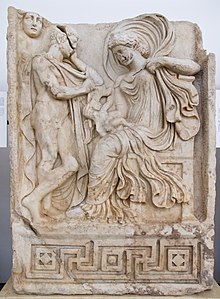
During the Hellenistic period, the Greeks identified Aphrodite with the ancient Egyptian goddesses Hathor and Isis.[85][86][87] Aphrodite was the patron goddess of the Lagid queens[88] and Queen Arsinoe II was identified as her mortal incarnation.[88] Aphrodite was worshipped in Alexandria[88] and had numerous temples in and around the city.[88] Arsinoe II introduced the cult of Adonis to Alexandria and many of the women there partook in it.[88] The Tessarakonteres, a gigantic catamaran galley designed by Archimedes for Ptolemy IV Philopator, had a circular temple to Aphrodite on it with a marble statue of the goddess herself.[88] In the second century BC, Ptolemy VIII Physcon and his wives Cleopatra II and Cleopatra III dedicated a temple to Aphrodite Hathor at Philae.[88] Statuettes of Aphrodite for personal devotion became common in Egypt starting in the early Ptolemaic times and extending until long after Egypt became a Roman province.[88]
The ancient Romans identified Aphrodite with their goddess Venus,[89] who was originally a goddess of agricultural fertility, vegetation, and springtime.[89] According to the Roman historian Livy, Aphrodite and Venus were officially identified in the third century BC[90] when the cult of Venus Erycina was introduced to Rome from the Greek sanctuary of Aphrodite on Mount Eryx in Sicily.[90] After this point, Romans adopted Aphrodite's iconography and myths and applied them to Venus.[90] Because Aphrodite was the mother of the Trojan hero Aeneas in Greek mythology[90] and Roman tradition claimed Aeneas as the founder of Rome,[90] Venus became venerated as Venus Genetrix, the mother of the entire Roman nation.[90] Julius Caesar claimed to be directly descended from Aeneas's son Iulus[91] and became a strong proponent of the cult of Venus.[91] This precedent was later followed by his nephew Augustus and the later emperors claiming succession from him.[91]
This syncretism greatly impacted Greek worship of Aphrodite.[92] During the Roman era, the cults of Aphrodite in many Greek cities began to emphasize her relationship with Troy and Aeneas.[92] They also began to adopt distinctively Roman elements,[92] portraying Aphrodite as more maternal, more militaristic, and more concerned with administrative bureaucracy.[92] She was claimed as a divine guardian by many political magistrates.[92] Appearances of Aphrodite in Greek literature also vastly proliferated, usually showing Aphrodite in a characteristically Roman manner.[93]
Mythology
Birth
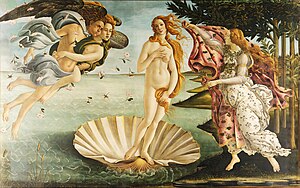
Aphrodite is usually said to have been born near her chief center of worship, Paphos, on the island of Cyprus, which is why she is sometimes called "Cyprian", especially in the poetic works of Sappho. The Sanctuary of Aphrodite Paphia, marking her birthplace, was a place of pilgrimage in the ancient world for centuries.[95] Other versions of her myth have her born near the island of Cythera, hence another of her names, "Cytherea".[96] Cythera was a stopping place for trade and culture between Crete and the Peloponesus,[97] so these stories may preserve traces of the migration of Aphrodite's cult from the Middle East to mainland Greece.[98]
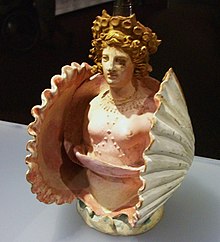

According to the version of her birth recounted by Hesiod in his Theogony,[99][100] Cronus severed Uranus' genitals and threw them behind him into the sea.[100][101][102] The foam from his genitals gave rise to Aphrodite[5] (hence her name, which Hesiod interprets as "foam-arisen"),[5] while the Giants, the Erinyes (furies), and the Meliae emerged from the drops of his blood.[100][101] Hesiod states that the genitals "were carried over the sea a long time, and white foam arose from the immortal flesh; with it a girl grew." After Aphrodite was born from the sea-foam, she washed up to shore in the presence of the other gods. Hesiod's account of Aphrodite's birth following Uranus's castration is probably derived from The Song of Kumarbi,[103][104] an ancient Hittite epic poem in which the god Kumarbi overthrows his father Anu, the god of the sky, and bites off his genitals, causing him to become pregnant and give birth to Anu's children, which include Ishtar and her brother Teshub, the Hittite storm god.[103][104]
In the Iliad,[105] Aphrodite is described as the daughter of Zeus and Dione.[5] Dione's name appears to be a feminine cognate to Dios and Dion,[5] which are oblique forms of the name Zeus.[5] Zeus and Dione shared a cult at Dodona in northwestern Greece.[5] In the Theogony, Hesiod describes Dione as an Oceanid,[106] but Apollodorus makes her the thirteenth Titan, child of Gaia and Uranus.[107]
Marriage

Aphrodite is consistently portrayed as a nubile, infinitely desirable adult, having had no childhood.[108] She is often depicted nude.[109] In the Iliad, Aphrodite is the apparently unmarried consort of Ares, the god of war,[110] and the wife of Hephaestus is a different goddess named Charis.[111] Likewise, in Hesiod's Theogony, Aphrodite is unmarried and the wife of Hephaestus is Aglaea, the youngest of the three Charites.[111]
In Book Eight of the Odyssey,[112] however, the blind singer Demodocus describes Aphrodite as the wife of Hephaestus and tells how she committed adultery with Ares during the Trojan War.[111][113] The sun-god Helios saw Aphrodite and Ares having sex in Hephaestus's bed and warned Hephaestus, who fashioned a fine, near invisible net.[113] The next time Ares and Aphrodite had sex together, the net trapped them both.[113] Hephaestus brought all the gods into the bedchamber to laugh at the captured adulterers,[114] but Apollo, Hermes, and Poseidon had sympathy for Ares[115] and Poseidon agreed to pay Hephaestus for Ares's release.[116] Aphrodite returned to her temple in Cyprus, where she was attended by the Charites.[116] This narrative probably originated as a Greek folk tale, originally independent of the Odyssey.[117] In a much later interpolated detail, Ares put the young soldier Alectryon by the door to warn of Helios's arrival but Alectryon fell asleep on guard duty.[118] Helios discovered the two and alerted Hephaestus; Ares in rage turned Alectryon into a rooster, which unfailingly crows to announce the sunrise.[119]
After exposing them, Hephaestus asks Zeus for his wedding gifts and dowry to be returned to him;[120] by the time of the Trojan War, he is married to Charis/Aglaea, one of the Graces, apparently divorced from Aphrodite.[111][121] Afterwards, it was generally Ares who was regarded as the husband or official consort of the goddess; on the François Vase, the two arrive at the wedding of Peleus and Thetis on the same chariot, as do Zeus with Hera and Poseidon with Amphitrite. The poets Pindar and Aeschylus refer to Ares as Aphrodite's husband.[122]
Later stories were invented to explain Aphrodite's marriage to Hephaestus. In the most famous story, Zeus hastily married Aphrodite to Hephaestus in order to prevent the other gods from fighting over her.[123] In another version of the myth, Hephaestus gave his mother Hera a golden throne, but when she sat on it, she became trapped and he refused to let her go until she agreed to give him Aphrodite's hand in marriage.[124] Hephaestus was overjoyed to be married to the goddess of beauty, and forged her beautiful jewelry, including a strophion (στρόφιον) known as the kestos himas (κεστὸς ἱμάς),[125] a saltire-shaped undergarment (usually translated as the girdle of Aphrodite),[126] which accentuated her breasts[127] and made her even more irresistible to men.[126] Such strophia were commonly used in depictions of the Near Eastern goddesses Ishtar and Atargatis.[126]
Attendants

Aphrodite is almost always accompanied by Eros, the god of lust and sexual desire.[130] In his Theogony, Hesiod describes Eros as one of the four original primeval forces born at the beginning of time,[130] but, after the birth of Aphrodite from the sea foam, he is joined by Himeros and, together, they become Aphrodite's constant companions.[131] In early Greek art, Eros and Himeros are both shown as idealized handsome youths with wings.[132] The Greek lyric poets regarded the power of Eros and Himeros as dangerous, compulsive, and impossible for anyone to resist.[133] In modern times, Eros is often seen as Aphrodite's son,[134] but this is actually a comparatively late innovation.[135] A scholion on Theocritus's Idylls remarks that the sixth-century BC poet Sappho had described Eros as the son of Aphrodite and Uranus,[136] but the first surviving reference to Eros as Aphrodite's son comes from Apollonius of Rhodes's Argonautica, written in the third century BC, which makes him the son of Aphrodite and Ares.[137] Later, the Romans, who saw Venus as a mother goddess, seized on this idea of Eros as Aphrodite's son and popularized it,[137] making it the predominant portrayal in works on mythology until the present day.[137]
Aphrodite's main attendants were the three Charites, whom Hesiod identifies as the daughters of Zeus and Eurynome and names as Aglaea ("Splendor"), Euphrosyne ("Good Cheer"), and Thalia ("Abundance").[138] The Charites had been worshipped as goddesses in Greece since the beginning of Greek history, long before Aphrodite was introduced to the pantheon.[111] Aphrodite's other set of attendants was the three Horae (the "Hours"),[111] whom Hesiod identifies as the daughters of Zeus and Themis and names as Eunomia ("Good Order"), Dike ("Justice"), and Eirene ("Peace").[139] Aphrodite was also sometimes accompanied by Harmonia, her daughter by Ares, and Hebe, the daughter of Zeus and Hera.[140]
The fertility god Priapus was usually considered to be Aphrodite's son by Dionysus,[141][142] but he was sometimes also described as her son by Hermes, Adonis, or even Zeus.[141] A scholion on Apollonius of Rhodes's Argonautica[143] states that, while Aphrodite was pregnant with Priapus, Hera envied her and applied an evil potion to her belly while she was sleeping to ensure that the child would be hideous.[141] In another version, Hera cursed Aphrodite's unborn son because he had been fathered by Zeus.[144] When Aphrodite gave birth, she was horrified to see that the child had a massive, permanently erect penis, a potbelly, and a huge tongue.[141] Aphrodite abandoned the infant to die in the wilderness, but a herdsman found him and raised him, later discovering that Priapus could use his massive penis to aid in the growth of plants.[141]
Anchises

The First Homeric Hymn to Aphrodite (Hymn 5), which was probably composed sometime in the mid-seventh century BC,[145] describes how Zeus once became annoyed with Aphrodite for causing deities to fall in love with mortals,[145] so he caused her to fall in love with Anchises, a handsome mortal shepherd who lived in the foothills beneath Mount Ida near the city of Troy.[145] Aphrodite appears to Anchises in the form of a tall, beautiful, mortal virgin while he is alone in his home.[146] Anchises sees her dressed in bright clothing and gleaming jewelry, with her breasts shining with divine radiance.[147] He asks her if she is Aphrodite and promises to build her an altar on top of the mountain if she will bless him and his family.[148]
Aphrodite lies and tells him that she is not a goddess, but the daughter of one of the noble families of Phrygia.[148] She claims to be able to understand the Trojan language because she had a Trojan nurse as a child and says that she found herself on the mountainside after she was snatched up by Hermes while dancing in a celebration in honor of Artemis, the goddess of virginity.[148] Aphrodite tells Anchises that she is still a virgin and begs him to take her to his parents.[148] Anchises immediately becomes overcome with mad lust for Aphrodite and swears that he will have sex with her.[148] Anchises takes Aphrodite, with her eyes cast downwards, to his bed, which is covered in the furs of lions and bears.[149] He then strips her naked and makes love to her.[149]
After the lovemaking is complete, Aphrodite reveals her true divine form.[150] Anchises is terrified, but Aphrodite consoles him and promises that she will bear him a son.[150] She prophesies that their son will be the demigod Aeneas, who will be raised by the nymphs of the wilderness for five years before going to Troy to become a nobleman like his father.[151] The story of Aeneas's conception is also mentioned in Hesiod's Theogony and in Book II of Homer's Iliad.[151][152]
Adonis
The myth of Aphrodite and Adonis is probably derived from the ancient Sumerian legend of Inanna and Dumuzid.[153][154][155] The Greek name Ἄδωνις (Adōnis, Greek pronunciation: [ádɔːnis]) is derived from the Canaanite word ʼadōn, meaning "lord".[156][155] The earliest known Greek reference to Adonis comes from a fragment of a poem by the Lesbian poet Sappho (c. 630 – c. 570 BC), in which a chorus of young girls asks Aphrodite what they can do to mourn Adonis's death.[157] Aphrodite replies that they must beat their breasts and tear their tunics.[157] Later references flesh out the story with more details.[158] According to the retelling of the story found in the poem Metamorphoses by the Roman poet Ovid (43 BC – 17/18 AD), Adonis was the son of Myrrha, who was cursed by Aphrodite with insatiable lust for her own father, King Cinyras of Cyprus, after Myrrha's mother bragged that her daughter was more beautiful than the goddess.[159] Driven out after becoming pregnant, Myrrha was changed into a myrrh tree, but still gave birth to Adonis.[160]
Aphrodite found the baby and took him to the underworld to be fostered by Persephone.[161] She returned for him once he was grown and discovered him to be strikingly handsome.[161] Persephone wanted to keep Adonis, resulting in a custody battle between the two goddesses over whom should rightly possess Adonis.[161] Zeus settled the dispute by decreeing that Adonis would spend one third of the year with Aphrodite, one third with Persephone, and one third with whomever he chose.[161] Adonis chose to spend that time with Aphrodite.[161] Then, one day, while Adonis was hunting, he was wounded by a wild boar and bled to death in Aphrodite's arms.[161] In a semi-mocking work, the Dialogues of the Gods, the satirical author Lucian comedically relates how a frustrated Aphrodite complains to the moon goddess Selene about her son Eros making Persephone fall in love with Adonis and now she has to share him with her.[162]
In different versions of the story, the boar was either sent by Ares, who was jealous that Aphrodite was spending so much time with Adonis, or by Artemis, who wanted revenge against Aphrodite for having killed her devoted follower Hippolytus.[163] In another version, Apollo in fury changed himself into a boar and killed Adonis because Aphrodite had blinded his son Erymanthus when he stumbled upon Aphrodite naked as she was bathing after intercourse with Adonis.[164] The story also provides an etiology for Aphrodite's associations with certain flowers.[163] Reportedly, as she mourned Adonis's death, she caused anemones to grow wherever his blood fell and declared a festival on the anniversary of his death.[161] In one version of the story, Aphrodite injured herself on a thorn from a rose bush and the rose, which had previously been white, was stained red by her blood.[163] According to Lucian's On the Syrian Goddess,[112] each year during the festival of Adonis, the Adonis River in Lebanon (now known as the Abraham River) ran red with blood.[161]
The myth of Adonis is associated with the festival of the Adonia, which was celebrated by Greek women every year in midsummer.[155] The festival, which was evidently already celebrated in Lesbos by Sappho's time, seems to have first become popular in Athens in the mid-fifth century BC.[155] At the start of the festival, the women would plant a "garden of Adonis", a small garden planted inside a small basket or a shallow piece of broken pottery containing a variety of quick-growing plants, such as lettuce and fennel, or even quick-sprouting grains such as wheat and barley.[155] The women would then climb ladders to the roofs of their houses, where they would place the gardens out under the heat of the summer sun.[155] The plants would sprout in the sunlight but wither quickly in the heat.[165] Then the women would mourn and lament loudly over the death of Adonis,[166] tearing their clothes and beating their breasts in a public display of grief.[166]
Divine favoritism
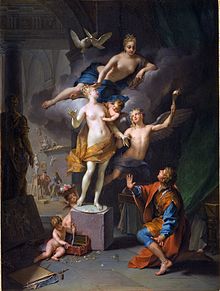
In Hesiod's Works and Days, Zeus orders Aphrodite to make Pandora, the first woman, physically beautiful and sexually attractive,[167] so that she may become "an evil men will love to embrace".[168] Aphrodite "spills grace" over Pandora's head[167] and equips her with "painful desire and knee-weakening anguish", thus making her the perfect vessel for evil to enter the world.[169] Aphrodite's attendants, Peitho, the Charites, and the Horae, adorn Pandora with gold and jewelry.[170]
According to one myth, Aphrodite aided Hippomenes, a noble youth who wished to marry Atalanta, a maiden who was renowned throughout the land for her beauty, but who refused to marry any man unless he could outrun her in a footrace.[171][172] Atalanta was an exceedingly swift runner and she beheaded all of the men who lost to her.[171][172] Aphrodite gave Hippomenes three golden apples from the Garden of the Hesperides and instructed him to toss them in front of Atalanta as he raced her.[171][173] Hippomenes obeyed Aphrodite's order[171] and Atalanta, seeing the beautiful, golden fruits, bent down to pick up each one, allowing Hippomenes to outrun her.[171][173] In the version of the story from Ovid's Metamorphoses, Hippomenes forgets to repay Aphrodite for her aid,[174][171] so she causes the couple to become inflamed with lust while they are staying at the temple of Cybele.[171] The couple desecrate the temple by having sex in it, leading Cybele to turn them into lions as punishment.[174][171]
The myth of Pygmalion is first mentioned by the third-century BC Greek writer Philostephanus of Cyrene,[175][176] but is first recounted in detail in Ovid's Metamorphoses.[175] According to Ovid, Pygmalion was an exceedingly handsome sculptor from the island of Cyprus, who was so sickened by the immorality of women that he refused to marry.[177][178] He fell madly and passionately in love with the ivory cult statue he was carving of Aphrodite and longed to marry it.[177][179] Because Pygmalion was extremely pious and devoted to Aphrodite,[177][180] the goddess brought the statue to life.[177][180] Pygmalion married the girl the statue became and they had a son named Paphos, after whom the capital of Cyprus received its name.[177][180] Pseudo-Apollodorus later mentions "Metharme, daughter of Pygmalion, king of Cyprus".[181]
Anger myths
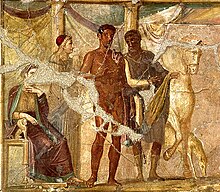
Aphrodite generously rewarded those who honored her, but also punished those who disrespected her, often quite brutally.[183] A myth described in Apollonius of Rhodes's Argonautica and later summarized in the Bibliotheca of Pseudo-Apollodorus tells how, when the women of the island of Lemnos refused to sacrifice to Aphrodite, the goddess cursed them to stink horribly so that their husbands would never have sex with them.[184] Instead, their husbands started having sex with their Thracian slave-girls.[184] In anger, the women of Lemnos murdered the entire male population of the island, as well as all the Thracian slaves.[184] When Jason and his crew of Argonauts arrived on Lemnos, they mated with the sex-starved women under Aphrodite's approval and repopulated the island.[184] From then on, the women of Lemnos never disrespected Aphrodite again.[184]

In Euripides's tragedy Hippolytus, which was first performed at the City Dionysia in 428 BC, Theseus's son Hippolytus worships only Artemis, the goddess of virginity, and refuses to engage in any form of sexual contact.[184] Aphrodite is infuriated by his prideful behavior[185] and, in the prologue to the play, she declares that, by honoring only Artemis and refusing to venerate her, Hippolytus has directly challenged her authority.[186] Aphrodite therefore causes Hippolytus's stepmother, Phaedra, to fall in love with him, knowing Hippolytus will reject her.[187] After being rejected, Phaedra commits suicide and leaves a suicide note to Theseus telling him that she killed herself because Hippolytus attempted to rape her.[187] Theseus prays to Poseidon to kill Hippolytus for his transgression.[188] Poseidon sends a wild bull to scare Hippolytus's horses as he is riding by the sea in his chariot, causing the horses to bolt and smash the chariot against the cliffs, dragging Hippolytus to a bloody death across the rocky shoreline.[188] The play concludes with Artemis vowing to kill Aphrodite's own mortal beloved (presumably Adonis) in revenge.[189]
Glaucus of Corinth angered Aphrodite by refusing to let his horses for chariot racing mate, since doing so would hinder their speed.[190] During the chariot race at the funeral games of King Pelias, Aphrodite drove his horses mad and they tore him apart.[191] Polyphonte was a young woman who chose a virginal life with Artemis instead of marriage and children, as favoured by Aphrodite. Aphrodite cursed her, causing her to have children by a bear. The resulting offspring, Agrius and Oreius, were wild cannibals who incurred the hatred of Zeus. Ultimately, he transformed all the members of the family into birds of ill omen.[192]
According to Apollodorus, a jealous Aphrodite cursed Eos, the goddess of dawn, to be perpetually in love and have insatiable sexual desire because Eos once had lain with Aphrodite's sweetheart Ares, the god of war.[193]

According to Ovid in his Metamorphoses (book 10.238 ff.), Propoetides who are the daughters of Propoetus from the city of Amathus on the island of Cyprus denied Aphrodite's divinity and failed to worship her properly. Therefore, Aphrodite turned them into the world's first prostitutes.[194] According to Diodorus Siculus, when the Rhodian sea nymphe Halia's six sons by Poseidon arrogantly refused to let Aphrodite land upon their shore, the goddess cursed them with insanity. In their madness, they raped Halia. As punishment, Poseidon buried them in the island's sea-caverns.[195]
Xanthius, a descendant of Bellerophon, had two children: Leucippus and an unnamed daughter. Through the wrath of Aphrodite (reasons unknown), Leucippus fell in love with his own sister. They started a secret relationship but the girl was already betrothed to another man and he went on to inform her father Xanthius, without telling him the name of the seducer. Xanthius went straight to his daughter's chamber, where she was together with Leucippus right at the moment. On hearing him enter, she tried to escape, but Xanthius hit her with a dagger, thinking that he was slaying the seducer, and killed her. Leucippus, failing to recognize his father at first, slew him. When the truth was revealed, he had to leave the country and took part in colonization of Crete and the lands in Asia Minor.[196]
Queen Cenchreis of Cyprus, wife of King Cinyras, bragged that her daughter Myrrha was more beautiful than Aphrodite. Therefore, Myrrha was cursed by Aphrodite with insatiable lust for her own father, King Cinyras of Cyprus and he slept with her unknowingly in the dark. She eventually transformed into the myrrh tree and gave birth to Adonis in this form.[197][159][160][198] Cinyras also had three other daughters: Braesia, Laogora, and Orsedice. These girls by the wrath of Aphrodite (reasons unknown) cohabited with foreigners and ended their life in Egypt.[199]
The Muse Clio derided the goddess' own love for Adonis. Therefore, Clio fell in love with Pierus, son of Magnes and bore Hyacinth.[200]
Aegiale was a daughter of Adrastus and Amphithea and was married to Diomedes. Because of anger of Aphrodite, whom Diomedes had wounded in the war against Troy, she had multiple lovers, including a certain Hippolytus.[201][202] when Aegiale went so far as to threaten his life, he fled to Italy.[202][203] According to Stesichorus and Hesiod while Tyndareus sacrificing to the gods he forgot Aphrodite, therefore the goddess made his daughters twice and thrice wed and deserters of their husbands. Timandra deserted Echemus and went and came to Phyleus and Clytaemnestra deserted Agamemnon and lay with Aegisthus who was a worse mate for her and eventually killed her husband with her lover and finally, Helen of Troy deserted Menelaus under the influence of Aphrodite for Paris and her unfaitfulness eventually causes the War of Troy.[204] As a result of her actions, Aphrodite caused the War of Troy in order to take Priam's kingdom and pass it down to her descendants.[205]
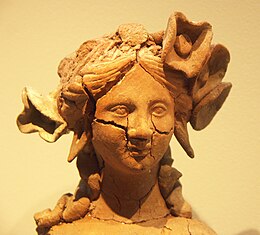
In one of the versions of the legend, Pasiphae did not make offerings to the goddess Venus [Aphrodite]. Because of this Venus [Aphrodite] inspired in her an unnatural love for a bull[206] or she cursed her because she was Helios's daughter who revealed her adultery to Hephaestus.[207][208] For Helios' own tale-telling, she cursed him with uncontrollable lust over the mortal princess Leucothoe, which led to him abandoning his then-lover Clytie, leaving her heartbroken.[209]
Lysippe was the mother of Tanais by Berossos. Her son only venerated Ares and was fully devoted to war, neglecting love and marriage. Aphrodite cursed him with falling in love with his own mother. Preferring to die rather than give up his chastity, he threw himself into the river Amazonius, which was subsequently renamed Tanais.[210]
According to Hyginus, At the behest of Zeus, Orpheus's mother, the Muse Calliope, judged the dispute between the goddesses Aphrodite and Persephone over Adonis and decided that both shall possess him half of the year. This enraged Venus [Aphrodite], because she had not been granted what she thought was her right. Therefore, Venus [Aphrodite] inspired love for Orpheus in the women of Thrace, causing them to tear him apart as each of them sought Orpheus for herself.[211]
Aphrodite personally witnessed the young huntress Rhodopis swear eternal devotion and chastity to Artemis when she joined her group. Aphrodite then summoned her son Eros, and convinced him that such lifestyle was an insult to them both. So under her command, Eros made Rhodopis and Euthynicus, another young hunter who had shunned love and romance just like her, to fall in love with each other. Despite their chaste life, Rhodopis and Euthynicus withdrew to some cavern where they violated their vows. Artemis was not slow to take notice after seeing Aphrodite laugh, so she changed Rhodopis into a fountain as a punishment.[212][213]
Judgment of Paris and Trojan War

The myth of the Judgement of Paris is mentioned briefly in the Iliad,[214] but is described in depth in an epitome of the Cypria, a lost poem of the Epic Cycle,[215] which records that all the gods and goddesses as well as various mortals were invited to the marriage of Peleus and Thetis (the eventual parents of Achilles).[214] Only Eris, goddess of discord, was not invited.[215] She was annoyed at this, so she arrived with a golden apple inscribed with the word καλλίστῃ (kallistēi, "for the fairest"), which she threw among the goddesses.[216] Aphrodite, Hera, and Athena all claimed to be the fairest, and thus the rightful owner of the apple.[216]
The goddesses chose to place the matter before Zeus, who, not wanting to favor one of the goddesses, put the choice into the hands of Paris, a Trojan prince.[216] After bathing in the spring of Mount Ida where Troy was situated, the goddesses appeared before Paris for his decision.[216] In the extant ancient depictions of the Judgement of Paris, Aphrodite is only occasionally represented nude, and Athena and Hera are always fully clothed.[217] Since the Renaissance, however, Western paintings have typically portrayed all three goddesses as completely naked.[217]
All three goddesses were ideally beautiful and Paris could not decide between them, so they resorted to bribes.[216] Hera tried to bribe Paris with power over all Asia and Europe,[216] and Athena offered wisdom, fame and glory in battle,[216] but Aphrodite promised Paris that, if he were to choose her as the fairest, she would let him marry the most beautiful woman on earth.[218] This woman was Helen, who was already married to King Menelaus of Sparta.[218] Paris selected Aphrodite and awarded her the apple.[218] The other two goddesses were enraged and, as a direct result, sided with the Greeks in the Trojan War.[218]
Aphrodite plays an important and active role throughout the entirety of Homer's Iliad.[219] In Book III, she rescues Paris from Menelaus after he foolishly challenges him to a one-on-one duel.[220] She then appears to Helen in the form of an old woman and attempts to persuade her to have sex with Paris,[221] reminding her of his physical beauty and athletic prowess.[222] Helen immediately recognizes Aphrodite by her beautiful neck, perfect breasts, and flashing eyes[223] and chides the goddess, addressing her as her equal.[224] Aphrodite sharply rebukes Helen, reminding her that, if she vexes her, she will punish her just as much as she has favored her already.[225] Helen demurely obeys Aphrodite's command.[225]
In Book V, Aphrodite charges into battle to rescue her son Aeneas from the Greek hero Diomedes.[226] Diomedes recognizes Aphrodite as a "weakling" goddess[226] and, thrusting his spear, nicks her wrist through her "ambrosial robe".[227] Aphrodite borrows Ares's chariot to ride back to Mount Olympus.[228] Zeus chides her for putting herself in danger,[228][229] reminding her that "her specialty is love, not war."[228] According to Walter Burkert, this scene directly parallels a scene from Tablet VI of the Epic of Gilgamesh in which Ishtar, Aphrodite's Akkadian precursor, cries to her mother Antu after the hero Gilgamesh rejects her sexual advances, but is mildly rebuked by her father Anu.[230] In Book XIV of the Iliad, during the Dios Apate episode, Aphrodite lends her kestos himas to Hera for the purpose of seducing Zeus and distracting him from the combat while Poseidon aids the Greek forces on the beach.[231] In the Theomachia in Book XXI, Aphrodite again enters the battlefield to carry Ares away after he is wounded.[228][232]
Offspring

Sometimes poets and dramatists recounted ancient traditions, which varied, and sometimes they invented new details; later scholiasts might draw on either or simply guess.[233][234] Thus while Aeneas and Phobos were regularly described as offspring of Aphrodite, others listed here such as Priapus and Eros were sometimes said to be children of Aphrodite but with varying fathers and sometimes given other mothers or none at all.
| Offspring | Father |
|---|---|
| Aeneas, Lyrus/Lyrnus[235] | Anchises |
| Phobos,[236] Deimos,[236] Harmonia,[140][236] the Erotes (Eros,[237][131] Anteros,[b] Himeros,[131] Pothos)[236] | Ares[111][236] |
| Hymenaios, Iacchus, Priapus,[141] the Charites (Graces: Aglaea, Euphrosyne, Thalia) | Dionysus |
| Hermaphroditos,[238] Priapus[141] | Hermes |
| Rhodos[239] | Poseidon |
| Beroe, Golgos,[240] Priapus (rarely)[141] | Adonis[161][163] |
| Eryx,[241] Meligounis and several more unnamed daughters[242] | Butes[243][244] |
| Astynous[245] | Phaethon[246] |
| Priapus[144] | Zeus |
| Peitho[247] | unknown |
Iconography
Symbols

Rich-throned immortal Aphrodite,
scheming daughter of Zeus, I pray you,
with pain and sickness, Queen, crush not my heart,
but come, if ever in the past you heard my voice from afar and hearkened,
and left your father's halls and came, with gold
chariot yoked; and pretty sparrows
brought you swiftly across the dark earth
fluttering wings from heaven through the air.
Aphrodite's most prominent avian symbol was the dove,[249] which was originally an important symbol of her Near Eastern precursor Inanna-Ishtar.[250][251] (In fact, the ancient Greek word for "dove", peristerá, may be derived from a Semitic phrase peraḥ Ištar, meaning "bird of Ishtar".[250][251]) Aphrodite frequently appears with doves in ancient Greek pottery[249] and the temple of Aphrodite Pandemos on the southwest slope of the Athenian Acropolis was decorated with relief sculptures of doves with knotted fillets in their beaks.[252] Votive offerings of small, white, marble doves were also discovered in the temple of Aphrodite at Daphni.[252] In addition to her associations with doves, Aphrodite was also closely linked with sparrows[249] and she is described riding in a chariot pulled by sparrows in Sappho's "Ode to Aphrodite".[252] According to myth, the dove was originally a nymph named Peristera who helped Aphrodite win in a flower-picking contest over her son Eros; for this Eros turned her into a dove, but Aphrodite took the dove under her wing and made it her sacred bird.[253][254]
Because of her connections to the sea, Aphrodite was associated with a number of different types of water fowl,[255] including swans, geese, and ducks.[255] Aphrodite's other symbols included the sea, conch shells, and roses.[256] The rose and myrtle flowers were both sacred to Aphrodite.[257] A myth explaining the origin of Aphrodite's connection to myrtle goes that originally the myrtle was a maiden, Myrina, a dedicated priestess of Aphrodite. When her previous betrothed carried her away from the temple to marry her, Myrina killed him, and Aphrodite turned her into a myrtle, forever under her protection.[258] Her most important fruit emblem was the apple,[259] and in myth, she turned Melus, childhood friend and kin-in-law to Adonis, into an apple after he killed himself, mourning over Adonis' death. Likewise, Melus's wife Pelia was turned into a dove.[260] She was also associated with pomegranates,[261] possibly because the red seeds suggested sexuality[262] or because Greek women sometimes used pomegranates as a method of birth control.[262] In Greek art, Aphrodite is often also accompanied by dolphins and Nereids.[263]
In classical art
A scene of Aphrodite rising from the sea appears on the back of the Ludovisi Throne (c. 460 BC),[266] which was probably originally part of a massive altar that was constructed as part of the Ionic temple to Aphrodite in the Greek polis of Locri Epizephyrii in Magna Graecia in southern Italy.[266] The throne shows Aphrodite rising from the sea, clad in a diaphanous garment, which is drenched with seawater and clinging to her body, revealing her upturned breasts and the outline of her navel.[267] Her hair hangs dripping as she reaches to two attendants standing barefoot on the rocky shore on either side of her, lifting her out of the water.[267] Scenes with Aphrodite appear in works of classical Greek pottery,[268] including a famous white-ground kylix by the Pistoxenos Painter dating the between c. 470 and 460 BC, showing her riding on a swan or goose.[268] Aphrodite was often described as golden-haired and portrayed with this color hair in art.[269]
In c. 364/361 BC, the Athenian sculptor Praxiteles carved the marble statue Aphrodite of Knidos,[270][265] which Pliny the Elder later praised as the greatest sculpture ever made.[270] The statue showed a nude Aphrodite modestly covering her pubic region while resting against a water pot with her robe draped over it for support.[271][272] The Aphrodite of Knidos was the first full-sized statue to depict Aphrodite completely naked[273] and one of the first sculptures that was intended to be viewed from all sides.[274][273] The statue was purchased by the people of Knidos in around 350 BC[273] and proved to be tremendously influential on later depictions of Aphrodite.[274] The original sculpture has been lost,[270][272] but written descriptions of it as well several depictions of it on coins are still extant[275][270][272] and over sixty copies, small-scale models, and fragments of it have been identified.[275]
The Greek painter Apelles of Kos, a contemporary of Praxiteles, produced the panel painting Aphrodite Anadyomene (Aphrodite Rising from the Sea).[264] According to Athenaeus, Apelles was inspired to paint the painting after watching the courtesan Phryne take off her clothes, untie her hair, and bathe naked in the sea at Eleusis.[264] The painting was displayed in the Asclepeion on the island of Kos.[264] The Aphrodite Anadyomene went unnoticed for centuries,[264] but Pliny the Elder records that, in his own time, it was regarded as Apelles's most famous work.[264]
During the Hellenistic and Roman periods, statues depicting Aphrodite proliferated;[276] many of these statues were modeled at least to some extent on Praxiteles's Aphrodite of Knidos.[276] Some statues show Aphrodite crouching naked;[277] others show her wringing water out of her hair as she rises from the sea.[277] Another common type of statue is known as Aphrodite Kallipygos, the name of which is Greek for "Aphrodite of the Beautiful Buttocks";[277] this type of sculpture shows Aphrodite lifting her peplos to display her buttocks to the viewer while looking back at them from over her shoulder.[277] The ancient Romans produced massive numbers of copies of Greek sculptures of Aphrodite[276] and more sculptures of Aphrodite have survived from antiquity than of any other deity.[277]
-
The Ludovisi Throne (possibly c. 460 BC) is believed to be a classical Greek bas-relief, although it has also been alleged to be a 19th-century forgery.
-
Attic white-ground red-figured kylix of Aphrodite riding a swan (c. 46-470) found at Kameiros (Rhodes)
-
Aphrodite and Himeros, detail from a silver kantharos (c. 420-410 BC), part of the Vassil Bojkov collection, Sofia, Bulgaria
-
Red-figure vase painting of Aphrodite and Phaon (c. 420-400 BC)
-
Apuleian vase painting of Zeus plotting with Aphrodite to seduce Leda while Eros sits on her arm (c. 330 BC)
-
Aphrodite Leaning Against a Pillar (third century BC)
-
Aphrodite Kallipygos ("Aphrodite of the Beautiful Buttocks")
-
Aphrodite Binding Her Hair (second century BC)
-
Aphrodite of Milos (c. 100 BC), Louvre
-
Aphrodite statue at the Museum Willet-Holthuysen
-
Aphrodite Heyl (second century BC)
-
Greek sculpture group of Aphrodite, Pan and Eros (c. 100 BC)
-
Aphrodite of Menophantos (first century BC)
-
Aphrodite of Syracuse (Roman copy of 2nd century AD), NAMA.
-
The Lely Venus (c. second century AD)
-
Aphrodite Areia Roman copy, NAMA.
Post-classical culture

Middle Ages
Early Christians frequently adapted pagan iconography to suit Christian purposes.[278][279][280] In the Early Middle Ages, Christians adapted elements of Aphrodite/Venus's iconography and applied them to Eve and prostitutes,[279] but also female saints and even the Virgin Mary.[279] Christians in the east reinterpreted the story of Aphrodite's birth as a metaphor for baptism;[281] in a Coptic stele from the sixth century AD, a female orant is shown wearing Aphrodite's conch shell as a sign that she is newly baptized.[281] Throughout the Middle Ages, villages and communities across Europe still maintained folk tales and traditions about Aphrodite/Venus[282] and travelers reported a wide variety of stories.[282] Numerous Roman mosaics of Venus survived in Britain, preserving memory of the pagan past.[256] In North Africa in the late fifth century AD, Fulgentius of Ruspe encountered mosaics of Aphrodite[256] and reinterpreted her as a symbol of the sin of Lust,[256] arguing that she was shown naked because "the sin of lust is never cloaked"[256] and that she was often shown "swimming" because "all lust suffers shipwreck of its affairs."[256] He also argued that she was associated with doves and conches because these are symbols of copulation,[256] and that she was associated with roses because "as the rose gives pleasure, but is swept away by the swift movement of the seasons, so lust is pleasant for a moment, but is swept away forever."[256]
В то время как Фульгенций присвоил Афродиту как символ похоти, [283] Isidore of Seville (c. 560–636) interpreted her as a symbol of marital procreative sex[ 283 ] и заявил, что мораль истории о рождении Афродиты состоит в том, что секс может быть святым только при наличии семени, крови и тепла, которые он считал необходимыми для продолжения рода. [ 283 ] Тем временем Исидор очернил сына Афродиты/Венеры Эроса/Купидона как «демона блуда» ( daemon fornicationis ). [ 283 ] Афродита/Венера была наиболее известна западноевропейским ученым благодаря ее появлениям в «Энеиде » Овидия » Вергилия и «Метаморфозах . [ 284 ] Венера упоминается в латинской поэме Pervigilium Veneris («Канун Святой Венеры»), написанной в третьем или четвертом веке нашей эры. [ 285 ] и в Джованни Боккаччо » «Генеалогии языческих богов . [ 286 ]
Начиная с позднего средневековья . миф о Венусберге (нем.; франц. Mont de Vénus , «Гора Венеры») — подземном царстве, управляемом Венерой, скрытом под христианской Европой, — стал мотивом европейского фольклора, отраженным в различных легендах и эпосах. В немецком фольклоре XVI века повествование ассоциируется с миннезингером Тангейзером , и в этой форме миф был принят в более поздней литературе и опере.
Искусство
Афродита — центральная фигура Сандро Боттичелли картины «Примавера », которую описывают как «одну из самых написанных и самых противоречивых картин в мире». [ 287 ] и «одна из самых популярных картин западного искусства». [ 288 ] История рождения Афродиты из пены была популярной темой для художников эпохи итальянского Возрождения . [ 289 ] которые пытались сознательно реконструировать утраченный шедевр Апеллеса Косского «Афродита Анадиомена» литературного экфрасиса на основе его , сохранившегося Цицероном и Плинием Старшим. [ 290 ] Художники также черпали вдохновение из Овидием описания рождения Венеры в его «Метаморфозах» . [ 290 ] Картина Сандро Боттичелли «Рождение Венеры» ( ок. 1485) также была частично вдохновлена описанием Полициано рельефа на эту тему. [ 290 ] Более поздние итальянские интерпретации той же сцены включают Тициана » «Венеру Анадиомену ( ок. 1525 ). [ 290 ] и Стуфетте картина Рафаэля в « кардинала Биббиены» (1516 г.). [ 290 ] Биограф Тициана Джорджо Вазари идентифицировал все картины Тициана, изображающие обнаженных женщин, как картины «Венеры». [ 291 ] включая эротическую картину ок. 1534 г. , которую он назвал Венерой Урбино , хотя картина не содержит никакой традиционной иконографии Афродиты/Венеры, а женщина на ней четко показана в современной, а не классической обстановке. [ 291 ]
-
Примавера (конец 1470-х или начало 1480-х годов) работы Сандро Боттичелли .
-
Венера Урбино ( ок. 1534 ) работы Тициана
-
Венера и Адонис (1554) Тициана
-
Венера с зеркалом ( ок. 1555 ) картины Тициана
-
Туалет Венеры ( ок. 1612–1615) Питера Пауля Рубенса.
-
Смерть Адониса ( ок. 1614) Питера Пауля Рубенса
-
Рокби Венера ( ок. 1647–1651), автор Диего Веласкес.
-
Венера и Амур, оплакивающие мертвого Адониса (1656) Корнелиса Хольстейна
«Рождение Венеры » (1863) Александра Кабанеля Жака-Луи Давида Последней работой опус стал его выдающийся 1824 года «Марс, разоруженный Венерой» . [ 292 ] который сочетает в себе элементы классического, ренессансного, традиционного французского искусства и современных художественных стилей. [ 292 ] Работая над картиной, Дэвид описал ее, сказав: «Это последняя картина, которую я хочу написать, но я хочу превзойти в ней самого себя. Я поставлю на ней дату своих семидесяти пяти лет, а потом никогда больше не возьму в руки кисть». [ 293 ] Картина была выставлена сначала в Брюсселе, а затем в Париже, где ее пришло посмотреть более 10 000 человек. [ 293 ] Жана-Огюста-Доминика Энгра Картина «Венера Анадиомена» была одной из его главных работ. [ 294 ] Луи Жофруа описал это как «мечту юности, реализованную с силой зрелости, счастье, которое обретают немногие, художники или кто-то еще». [ 294 ] Теофиль Готье заявил: «От чудесной живописи греков ничего не осталось, но, несомненно, если что-то и могло дать идею античной живописи, как она была задумана по мотивам статуй Фидия и поэм Гомера, так это картина М. Энгра: Венера» . Анадиомена Апеллесова». Найдена [ 294 ] Другие критики отвергли это как образец лишенного воображения и сентиментального китча . [ 294 ] но сам Энгр считал это одной из своих величайших работ и использовал ту же фигуру, что и модель для своей более поздней картины 1856 года «Источник» . [ 294 ]
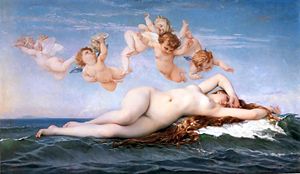
Картины Венеры были фаворитами академических художников конца девятнадцатого века во Франции. [ 295 ] [ 296 ] В 1863 году Александр Кабанель получил широкое признание критиков на Парижском салоне за картину «Рождение Венеры» , которую французский император Наполеон III немедленно приобрел для своей личной коллекции произведений искусства. [ 297 ] Картина Эдуарда Мане 1865 года «Олимпия» пародировала обнаженные Венеры академических художников, особенно «Рождение Венеры» Кабанеля . [ 298 ] В 1867 году английский академический художник Фредерик Лейтон выставил свою картину «Венера, раздевающаяся перед баней» . в академии [ 299 ] Искусствовед Дж. Б. Аткинсон похвалил это, заявив, что «г-н Лейтон, вместо того, чтобы перенимать испорченные римские представления о Венере, такие как воплощенные Рубенсом, мудро вернулся к греческой идее об Афродите, богине, которой поклонялись и которую художники изображали как совершенство женская грация и красота». [ 300 ] Год спустя английский художник Данте Габриэль Россетти , один из основателей Братства прерафаэлитов , нарисовал Венеру Вертикордию (лат. «Афродита, изменяющая сердца»), изображающую Афродиту в виде обнаженной рыжеволосой женщины в саду розы. [ 299 ] Хоть его и упрекали за экстравагантность темы, [ 299 ] Россетти отказался переделывать картину, и вскоре ее купил Дж. Митчелл из Брэдфорда. [ 300 ] В 1879 году Вильям Адольф Бугро выставил в Парижском салоне свою картину «Рождение Венеры» . [ 297 ] который имитировал классическую традицию контрапоста и был встречен широким признанием критиков, соперничая по популярности с версией Кабанеля, существовавшей почти два десятилетия назад. [ 297 ]
-
Венера и Адонис (1729) Франсуа Лемуана
-
Марс и Венера, удивленные Вулканом (1827) Александра Шарля Гиймо
-
Венера раздевается перед ванной (1867) Фредерика Лейтона
-
Рождение Венеры ( ок. 1879) автора Вильям-Адольф Бугро.
-
Рождение Венеры (1907) Анри Жервекса
Литература
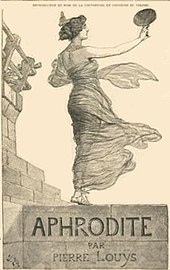
Уильяма Шекспира Эротическая поэма «Венера и Адонис» (1593), пересказ ухаживания Афродиты и Адониса из «Метаморфоз» Овидия . [ 301 ] [ 302 ] была самой популярной из всех его работ, опубликованных при его жизни. [ 303 ] [ 304 ] Перед смертью Шекспира было опубликовано шесть изданий этого произведения (больше, чем любого другого его произведения). [ 304 ] и он пользовался особенно большой популярностью среди молодежи. [ 303 ] В 1605 году Ричард Барнфилд хвалил это: [ 304 ] заявив, что стихотворение поместило имя Шекспира «в бессмертную славу Книги». [ 304 ] Несмотря на это, стихотворение было встречено неоднозначно современными критиками; [ 303 ] Сэмюэл Тейлор Кольридж защищал это: [ 303 ] но Сэмюэл Батлер жаловался, что ему это скучно [ 303 ] и К.С. Льюис охарактеризовал попытку прочтения его как «удушающую». [ 303 ]
Афродита появляется в Ричарда Гарнетта сборнике рассказов «Сумерки богов и другие сказки» (1888). [ 305 ] в котором христиане разрушили храмы богов. [ 306 ] Истории, вращающиеся вокруг скульптур Афродиты, были обычным явлением в конце девятнадцатого и начале двадцатого веков. [ 307 ] Примеры таких литературных произведений включают роман «Окрашенная Венера: фарсовый роман» (1885) Томаса Ансти Гатри и рассказ «Венера Ильская » (1887) Проспера Мериме . [ 308 ] оба из них посвящены оживающим статуям Афродиты. [ 308 ] Другой примечательный пример — «Афродита в Авлиде» англо-ирландского писателя Джорджа Мура . [ 309 ] который вращается вокруг древнегреческой семьи, которая переезжает в Авлиду . [ 310 ] Французский писатель Пьер Луи назвал свой эротический исторический роман «Афродита: антиквариат» (1896) в честь греческой богини. [ 311 ] Роман имел широкий коммерческий успех. [ 311 ] но возмутил французскую публику своей чувственностью и декадентским изображением греческого общества. [ 311 ]
В начале двадцатого века истории об Афродите использовали поэты -феминистки . [ 312 ] такие как Эми Лоуэлл и Алисия Острайкер . [ 313 ] Многие из этих стихотворений посвящены легендарному рождению Афродиты из пены морской. [ 312 ] Другие писатели-феминистки, в том числе Клод Кахун , Тит Йенсен и Анаис Нин , также использовали миф об Афродите в своих произведениях. [ 314 ] С момента публикации Изабель Альенде книги «Афродита: Мемуары чувств » в 1998 году имя «Афродита» использовалось в качестве названия для десятков книг, посвященных всем темам, даже поверхностно связанным с ее сферой деятельности. [ 315 ] Часто в этих книгах Афродита даже не упоминается. [ 315 ] или упоминайте ее лишь вкратце, но используйте ее имя как аргумент в пользу продажи. [ 316 ]
Современное поклонение
В 1938 году Глеб Боткин , русский иммигрант в США, основал Церковь Афродиты , неоязыческую религию, сосредоточенную вокруг поклонения богине -матери , которую ее последователи идентифицировали как Афродиту. [ 317 ] [ 318 ] Богословие Церкви Афродиты было изложено в книге « В поисках реальности» , вышедшей в 1969 году, за два года до смерти Боткина. [ 319 ] Книга изображала Афродиту в совершенно ином свете, чем тот, в котором ее представляли греки. [ 319 ] вместо этого назвав ее «единственной богиней несколько неоплатонического языческого монотеизма». [ 319 ] Утверждалось, что поклонение Афродите было принесено в Грецию учителем -мистиком Орфеем . [ 319 ] но что греки неправильно поняли учение Орфея и не осознали важности поклонения одной лишь Афродите. [ 319 ]
Афродита — главное божество в Викке . [ 320 ] [ 321 ] современная синкретическая неоязыческая религия, основанная на природе. [ 322 ] Виккане считают Афродиту одним из аспектов Богини. [ 321 ] и к ней часто обращаются по имени во время чар, связанных с любовью и романтикой. [ 323 ] [ 324 ] Виккане считают Афродиту повелительницей человеческих эмоций, эротической духовности, творчества и искусства. [ 320 ] Как одна из двенадцати олимпийцев, Афродита является главным божеством эллинизма (эллинского политеистического реконструкционизма). [ 325 ] [ 326 ] неоязыческая религия, которая стремится подлинно возродить и воссоздать религию Древней Греции в современном мире. [ 327 ] [ нужен лучший источник ] В отличие от виккан, эллинисты обычно являются строго политеистами или пантеистами. [ 328 ] [ нужен лучший источник ] Эллинисты почитают Афродиту прежде всего как богиню романтической любви. [ 326 ] [ нужен лучший источник ] но также как богиня сексуальности, моря и войны. [ 326 ] [ нужен лучший источник ] Среди ее многочисленных эпитетов - «Рожденный в море», «Убийца людей», «Она на могилах», «Честное плавание» и «Союзник на войне». [ 326 ] [ нужен лучший источник ]
Генеалогия
| Генеалогическое древо Афродиты [ 329 ] | |||||||||||||||||||||||||||||||||||||||||||||||||||||||||||||||||||||||||||||||||||||||||||||||||||||||||||||||||||||||||||||||||||||||||||||||||||||||||||||||||||||||||||||||||||||||||||||||||||||||||||||||||||||||||||||||||||||||||||||||||||||||||||||||||||||||||||||||||||||||||||||||||||||||||||||||||||||||||||||||||||||||||||||||||||||||||||||||||||||||||||||||||||||||||||||||||||||||||||||||||||||||||||||||||||||||||||||||||||||||||||||||||||||||||||||||||||||||||||||||||||||||||||||||||||||||||||||||||||||||||||||||||||||||||||||||||||||||||||||||||||||||||||||||||||||||||||||||||||||||||||||||||||||||||||||||||||||||||||||||||||||||||||||||||||||||||||||||||||||||||||||||||||||||||||||||||||||||||||||||||||||||||||||||||||||||||||||||||||||||||||||||||||||||||||||||||||||||||||||||||||||||||||||||||||||||||||||||||||||||||||||||||||||||||||||||||||||||||||||||||||||||||||||||||||||||||||||||||||||||||||||||||||||||||||||||||||||||||||||||||||||||||||||||||||||||||||||||||||||||
|---|---|---|---|---|---|---|---|---|---|---|---|---|---|---|---|---|---|---|---|---|---|---|---|---|---|---|---|---|---|---|---|---|---|---|---|---|---|---|---|---|---|---|---|---|---|---|---|---|---|---|---|---|---|---|---|---|---|---|---|---|---|---|---|---|---|---|---|---|---|---|---|---|---|---|---|---|---|---|---|---|---|---|---|---|---|---|---|---|---|---|---|---|---|---|---|---|---|---|---|---|---|---|---|---|---|---|---|---|---|---|---|---|---|---|---|---|---|---|---|---|---|---|---|---|---|---|---|---|---|---|---|---|---|---|---|---|---|---|---|---|---|---|---|---|---|---|---|---|---|---|---|---|---|---|---|---|---|---|---|---|---|---|---|---|---|---|---|---|---|---|---|---|---|---|---|---|---|---|---|---|---|---|---|---|---|---|---|---|---|---|---|---|---|---|---|---|---|---|---|---|---|---|---|---|---|---|---|---|---|---|---|---|---|---|---|---|---|---|---|---|---|---|---|---|---|---|---|---|---|---|---|---|---|---|---|---|---|---|---|---|---|---|---|---|---|---|---|---|---|---|---|---|---|---|---|---|---|---|---|---|---|---|---|---|---|---|---|---|---|---|---|---|---|---|---|---|---|---|---|---|---|---|---|---|---|---|---|---|---|---|---|---|---|---|---|---|---|---|---|---|---|---|---|---|---|---|---|---|---|---|---|---|---|---|---|---|---|---|---|---|---|---|---|---|---|---|---|---|---|---|---|---|---|---|---|---|---|---|---|---|---|---|---|---|---|---|---|---|---|---|---|---|---|---|---|---|---|---|---|---|---|---|---|---|---|---|---|---|---|---|---|---|---|---|---|---|---|---|---|---|---|---|---|---|---|---|---|---|---|---|---|---|---|---|---|---|---|---|---|---|---|---|---|---|---|---|---|---|---|---|---|---|---|---|---|---|---|---|---|---|---|---|---|---|---|---|---|---|---|---|---|---|---|---|---|---|---|---|---|---|---|---|---|---|---|---|---|---|---|---|---|---|---|---|---|---|---|---|---|---|---|---|---|---|---|---|---|---|---|---|---|---|---|---|---|---|---|---|---|---|---|---|---|---|---|---|---|---|---|---|---|---|---|---|---|---|---|---|---|---|---|---|---|---|---|---|---|---|---|---|---|---|---|---|---|---|---|---|---|---|---|---|---|---|---|---|---|---|---|---|---|---|---|---|---|---|---|---|---|---|---|---|---|---|---|---|---|---|---|---|---|---|---|---|---|---|---|---|---|---|---|---|---|---|---|---|---|---|---|---|---|---|---|---|---|---|---|---|---|---|---|---|---|---|---|---|---|---|---|---|---|---|---|---|---|---|---|---|---|---|---|---|---|---|---|---|---|---|---|---|---|---|---|---|---|---|---|---|---|---|---|---|---|---|---|---|---|---|---|---|---|---|---|---|---|---|---|---|---|---|---|---|---|---|---|---|---|---|---|---|---|---|---|---|---|---|---|---|---|---|---|---|---|---|---|---|---|---|---|---|---|---|---|---|---|---|---|---|---|---|---|---|---|---|---|---|---|---|---|---|---|---|---|---|---|---|---|---|---|---|---|---|---|---|---|---|---|---|---|---|---|---|---|---|---|---|---|---|---|---|---|---|---|---|---|---|---|---|---|---|---|---|---|---|---|---|---|---|---|---|---|---|---|---|---|---|---|---|---|---|---|---|---|---|---|---|---|---|---|---|---|---|---|---|---|---|---|---|---|---|---|---|---|---|---|---|---|---|---|---|---|---|---|---|---|---|---|---|---|---|---|---|---|---|---|---|---|---|---|---|---|---|---|---|---|---|---|---|---|---|---|---|---|---|---|---|---|---|---|---|---|---|---|---|---|---|---|---|---|---|---|---|---|---|---|---|---|---|---|---|---|---|---|---|---|---|---|---|---|---|---|---|---|---|---|---|---|---|---|---|---|---|---|---|---|---|---|---|---|---|---|---|---|---|---|---|---|---|---|---|---|---|---|---|---|---|---|---|---|---|---|---|---|---|---|---|---|---|---|---|---|---|---|---|---|---|---|---|---|---|---|---|---|---|---|---|---|---|---|---|---|---|---|---|---|---|---|---|---|---|---|---|---|---|---|---|---|---|---|---|---|---|---|---|---|---|---|---|---|---|---|---|---|---|---|---|---|---|---|---|---|---|---|---|---|---|---|---|---|---|---|---|---|---|---|---|---|---|---|---|---|---|---|---|---|---|---|---|---|---|---|---|---|---|---|---|---|---|---|
| |||||||||||||||||||||||||||||||||||||||||||||||||||||||||||||||||||||||||||||||||||||||||||||||||||||||||||||||||||||||||||||||||||||||||||||||||||||||||||||||||||||||||||||||||||||||||||||||||||||||||||||||||||||||||||||||||||||||||||||||||||||||||||||||||||||||||||||||||||||||||||||||||||||||||||||||||||||||||||||||||||||||||||||||||||||||||||||||||||||||||||||||||||||||||||||||||||||||||||||||||||||||||||||||||||||||||||||||||||||||||||||||||||||||||||||||||||||||||||||||||||||||||||||||||||||||||||||||||||||||||||||||||||||||||||||||||||||||||||||||||||||||||||||||||||||||||||||||||||||||||||||||||||||||||||||||||||||||||||||||||||||||||||||||||||||||||||||||||||||||||||||||||||||||||||||||||||||||||||||||||||||||||||||||||||||||||||||||||||||||||||||||||||||||||||||||||||||||||||||||||||||||||||||||||||||||||||||||||||||||||||||||||||||||||||||||||||||||||||||||||||||||||||||||||||||||||||||||||||||||||||||||||||||||||||||||||||||||||||||||||||||||||||||||||||||||||||||||||||||||
См. также
- Анхисы
- Ашера
- Амур
- Ремень Афродиты
- История обнаженного искусства
- Лакшми поднялась из океана, как Афродита, и имеет восьмиконечную звезду, как Иштар.
Пояснительные примечания
- ^ Национальный археологический музей (Неаполь). « так называемая Венера в бикини ». Cir.campania.beniculturali.it .
Статуэтка изображает Афродиту, готовую развязать шнурки сандалии на левой ноге, под которой приседает маленький Эрос, касаясь правой рукой подошвы ее туфельки. Богиня опирается левой рукой (кисть отсутствует) на фигуру Приапа, стоящего обнаженного и бородатого, стоящего на небольшом цилиндрическом алтаре, а рядом с ее левым бедром находится ствол дерева, над которым находится одежда богини. Богиня сложена. Афродита, почти полностью обнаженная, носит лишь своего рода костюм, состоящий из корсета, удерживаемого двумя парами бретелей, и двух коротких рукавов на верхней части руки, от которых длинная цепь ведет к ее бедрам и образует звезду. фигурный мотив на уровне пупка. «Бикини», которым известна статуэтка, получено путем виртуозного использования техники позолоты, которая также применялась на ее паху, в подвесном ожерелье и в армилле на правом запястье Афродиты, а также на фаллосе Приапа. . Следы красной краски заметны на стволе дерева, на коротких вьющихся волосах, собранных в пучок, на губах Богини, а также на головах Приапа и Эроса. Глаза Афродиты сделаны из стеклянной пасты, а наличие отверстий на уровне мочек ушей позволяет предположить существование сережек из драгоценного металла, которые с тех пор были утеряны. Статуэтка, вероятно, привезенная из Александрии, представляет собой интересное представление о женских украшениях римских времен и с некоторыми изменениями воспроизводит скульптурный тип Афродиты, развязывающей сандалии, известный по копиям из бронзы и терракоты.
Подробные исследования и библиографию по этой теме см.: de Franciscoscis 1963, p. 78, там же. XCI; Краус 1973, н.п. стр. 270–71. 194–95; Помпеи 1973, вып. 132; Помпеи 1973, вып. 199, с. 142 и 144; Помпеи 1974, вып. 281, с. 148–49; Помпеи 79 г. н. э., 1976 г., с. 83 и н. 218; Помпеи 79 г. н. э., 1978 г., I, n. 208, с. 64–65, II, вып. 208, с. 189; Дёль, Занкер 1979, с. 202, там же. Идет; Помпеи, 79 г. н. э., 1980 г., с. 79 и н. 198; Помпеи 1981, вып. 198, с. 107; Помпеи живы 1984, рис. 10, с. 46; Собрания музея 1989, I, 2, вып. 254, с. 146–47; ППМ II. 1990, вып. 7, с. 532; Армитт 1993, с. 240; Везувий 1995, вып. 53, с. 162–63; Вулкан 1995, вып. 53, с. 162–63; LIMC VIII, 1, 1997, с. 210, ул. Венеры, н. 182; LIMC VIII, 2, 1997, с. 144; LIMC VIII, 1, 1997, с. 1031, св Приапос, н. 15; LIMC VIII, 2, 1997, с. 680; Романтическая живопись 1998, вып. 153, с. 317 и с. п. 245; Кантарелла 1999, с. 128; Де Каро 1999, стр. 100–01; Де Каро 2000, с. 46 и гл. п. 62; Помпеи 2000, вып. 1, с. 62.
- ^ Антерос изначально родился в море вместе с Афродитой; только позже стал ее сыном.
Цитаты
- ^ Гомер, Илиада 5.370 .
- ^ Гесиод, Теогония , 188–90 .
- ^ Греческий : Афродита , транслит. Афродита ; Аттическое греческое произношение: [a.pʰro.dǐː.tɛː] , Койне Греческий : [a.ɸroˈdi.te̝] , Современный греческий : [a.froˈði.ti]
- ^ Это утверждение было сделано на Симпозиуме 180e. Трудно интерпретировать роль различных речей в диалоге и их связь с тем, что на самом деле думал Платон; поэтому остается спорным вопрос, действительно ли Платон верил этому утверждению об Афродите. См. Фрисби Шеффилд, «Роль ранних речей на «Симпозиуме»: эндоксический метод Платона?» в Дж. Х. Лешере, Дебре Нэйлс и Фрисби К.С. Шеффилд (ред.), « Симпозиум Платона: проблемы интерпретации и восприятия» . Издательство Гарвардского университета (2006).
- ^ Перейти обратно: а б с д и ж г час я Кирино 2010 , с. 14.
- ^ Гесиод, Теогония , 190–97 .
- ^ Перейти обратно: а б с д Вест 2000 , стр. 134–38.
- ^ Перейти обратно: а б с д и ж Бикс 2009 , с. 179.
- ^ Пол Кречмер , «О памфилийском диалекте», Журнал сравнительных лингвистических исследований в области индоевропейских языков 33 (1895): 267.
- ^ Эрнст Маас, «Афродита и святая Пелагия», Новогодние альбомы классической античности 27 (1911): 457–68.
- ^ Витторе Пизани, «Акмон и Диус», Archivio glottologico italiano 24 (1930): 65–73.
- ^ Перейти обратно: а б Янда 2005 , стр. 349–60.
- ^ Перейти обратно: а б с д Янда 2010 , с. 65.
- ^ Витчак 1993 , стр. 115–23.
- ^ Келлиган, Дэниел (2007). «Афродита Утренняя: индоевропейское наследие в греческих божественных эпитетах и теонимах» . Классические летрассы . 11 (11): 105–34. дои : 10.11606/issn.2358-3150.v0i11p105-134 .
- ^ Пенглас 1994 , с. 164.
- ^ Перейти обратно: а б Бодекер 1974 , стр. 15–16.
- ^ Кирино 2010 , стр. 26–27.
- ^ Кирино 2010 , с. 26.
- ^ Вест 2000 , стр. 134–36.
- ^ Вест 2000 , стр. 137–38.
- ^ Уилсон-Райт, Арен М. (август 2019 г.). Имя Венеры: Божественное имя Афродита как финикийский эпитет . Ежегодная конференция Европейской ассоциации библейских исследований. Варшава .
- ^ Чикагский ассирийский словарь , том. 2, с. 111.
- ^ М. Хаммарстрем, «Греко-этрусские словесные уравнения», Глотта: Журнал греческого и латинского языка 11 (1921): 215–16.
- ^ Перейти обратно: а б с Фриск 1960 , с. 196ф.
- ^ Перейти обратно: а б Вест 2000 , с. 134.
- ^ Этимологикум Магнум, Афродита.
- ^ О'Брайхим, Шон Дэвид (22 июня 2021 г.). Ученический комментарий к «Метаморфозам» Овидия. Книга 10 . США: Уайли-Блэквелл . п. 80 . ISBN 9781119770503 .
- ^ «Слово кипрского слогового письма а-по-ро-ти-та-и» . www.palaeolexicon.com . Проверено 24 апреля 2023 г.
- ^ Пестарино, Беатрис (8 августа 2022 г.). Киприон Политея, Политические и административные системы классических кипрских городов-королевств . Лейден, Нидерланды: Публикации Brill . стр. 135-136 . ISBN 9789004520332 .
- ^ Брайтенбергер 2007 , стр. 8–12.
- ^ Перейти обратно: а б Кирино 2010 , стр. 49–52.
- ^ Перейти обратно: а б Пухвель 1987 , с. 27.
- ^ Перейти обратно: а б Маркович 1996 , с. 43–59.
- ^ Буркерт 1985 , стр. 152–53.
- ^ Павсаний, Описание Греции, I. XIV.7.
- ^ Перейти обратно: а б с д Брайтенбергер 2007 , с. 8.
- ^ Перейти обратно: а б Брайтенбергер 2007 , стр. 10–11.
- ^ Пенглас 1994 , с. 162.
- ^ Пенглас 1994 , с. 163.
- ^ Перейти обратно: а б с д и Кирино 2010 , стр. 51–52.
- ^ Перейти обратно: а б с д и Будин 2010 , стр. 85–86, 96, 100, 102–03, 112, 123, 125.
- ^ Перейти обратно: а б Грац, 1984 , стр. 250.
- ^ Перейти обратно: а б Иосиф и Лорбер 2007 , с. 77.
- ^ Пенглас 1994 , стр. 162–63.
- ^ Перейти обратно: а б с Конарис 2016 , с. 169.
- ^ Перейти обратно: а б Буркерт 1998 , стр. 1–6.
- ^ Буркерт 1998 , стр. 1–41.
- ^ Перейти обратно: а б Дюмезиль 1934 год .
- ^ Перейти обратно: а б с д и Кирино 2010 , с. 24.
- ^ Пенглас 1994 , стр. 162–64.
- ^ Перейти обратно: а б с Кирино 2010 , стр. 24–25.
- ^ Кирино 2010 , с. 25.
- ^ Перейти обратно: а б с Буллоу и Буллоу 1993 , с. 29.
- ^ Перейти обратно: а б с д Кларк 2015 , с. 381.
- ^ Перейти обратно: а б с д Кереньи 1951 , с. 81.
- ^ Кирино 2010 , с. 28.
- ^ Перейти обратно: а б с д и ж г час Кереньи 1951 , с. 80.
- ^ Кирино 2010 , стр. 28–29.
- ^ Кирино 2010 , с. 35.
- ^ Перейти обратно: а б Кирино 2010 , стр. 35–38.
- ^ Платон , Симпозиум 181a-d.
- ^ Ричард Л. Хантер, Симпозиум Платона , Oxford University Press: 2004, стр. 44–47.
- ^ «Суда, π, 825» .
- ^ Павсаний, Периегесис vi.25.1; Афродита Пандемос была изображена в том же храме верхом на козле, символе чисто плотского полового акта: «Значение черепахи и козла я оставляю тем, кто желает догадаться», — замечает Павсаний. Изображение снова было использовано после эпохи Возрождения: см. Андреа Альсиато, Emblemata / Les Emblemes (1584) .
- ^ Перейти обратно: а б с д Кирино 2010 , с. 39.
- ^ Перейти обратно: а б с Кирино 2010 , стр. 39–40.
- ^ Перейти обратно: а б Кирино 2010 , с. 27.
- ^ Льюис Ричард Фарнелл (1896). Культы греческих государств . Кларендон Пресс. п. 666.
- ^ Колоски-Острув и Лионс 2000 , стр. 230–31.
- ^ Розенцвейг 2004 , стр. 15–16.
- ^ Саймон 1983 , стр. 49–50.
- ^ Перейти обратно: а б Саймон 1983 , с. 48.
- ^ Саймон 1983 , стр. 48–49.
- ^ Саймон 1983 , стр. 47–48.
- ^ Саймон 1983 , с. 49.
- ^ Кирино 2010 , с. 40.
- ^ Перейти обратно: а б Кирино 2010 , стр. 40–41.
- ^ Перейти обратно: а б с д Кирино 2010 , стр. 41–42.
- ^ Перейти обратно: а б с Маркович 1996 , с. 49.
- ^ Черное и Зеленое 1992 , с. 109.
- ^ Перейти обратно: а б Буркерт 1985 , с. 153.
- ^ Перейти обратно: а б Кирино 2010 , стр. 41–43.
- ^ Кирино 2010 , с. 43.
- ^ Витт 1997 , с. 125.
- ^ Дюнанд 2007 , с. 258.
- ^ Справочная энциклопедия Larousse Desk , The Book People, Haydock, 1995, стр. 215.
- ^ Перейти обратно: а б с д и ж г час Дюнанд 2007 , с. 257.
- ^ Перейти обратно: а б Кирино 2010 , стр. 127–28.
- ^ Перейти обратно: а б с д и ж Кирино 2010 , с. 128.
- ^ Перейти обратно: а б с Кирино 2010 , стр. 128–29.
- ^ Перейти обратно: а б с д и Кирино 2010 , с. 130.
- ^ Кирино 2010 , стр. 130–31.
- ^ Эймс-Льюис 2000 , с. 194.
- ^ [1] Архивировано 11 мая 2006 г. в Wayback Machine.
- ^ Homer, Odyssey viii. 288; Herodotus i. 105 ; Pausanias iii. 23. § 1 ; Anacreon v. 9; Horace, Carmina i. 4. 5.
- ^ Кирино 2010 , с. 21.
- ^ Кирино 2010 , стр. 20–21.
- ^ Гесиод, Теогония 191–192 .
- ^ Перейти обратно: а б с Кереньи 1951 , с. 69.
- ^ Перейти обратно: а б Грейвс 1960 , с. 37.
- ^ Кирино 2010 , стр. 13–14.
- ^ Перейти обратно: а б Кирино 2010 , с. 29.
- ^ Перейти обратно: а б Пухвель 1987 , с. 25.
- ^ Гомер , Илиада 5.370 и XX. 105
- ^ Кирино 2010 , стр. 14–15.
- ^ Аполлодор , 1.1.3
- ^ Кирино 2010 , стр. 53–61.
- ^ Кирино 2010 , стр. 73–78.
- ^ Кирино 2010 , стр. 50, 72.
- ^ Перейти обратно: а б с д и ж г Кирино 2010 , с. 72.
- ^ Перейти обратно: а б Кереньи 1951 , с. 279.
- ^ Перейти обратно: а б с Кереньи 1951 , с. 72.
- ^ Кереньи 1951 , стр. 72–73.
- ^ Кереньи 1951 , стр. 73–74.
- ^ Перейти обратно: а б Кереньи 1951 , с. 74.
- ^ Андерсон 2000 , стр. 131–32.
- ^ Галлахер, Дэвид (1 января 2009 г.). Птичий и Змеиный . Брилл Родопи. ISBN 978-90-420-2709-1 .
- ^ Лукиан , Галл 3 , см. также схолиаста по Аристофану , Птицы 835 ; Евстафий , Ad Odyssea 1.300; Авзоний, 26.2.27; Либаний, Прогимнасмата 2.26
- ^ Гомер , Одиссея 8.267 и далее
- ↑ Гомер , Илиада 18.382.
- ^ Хард, с. 202
- ^ Стуттард 2016 , с. 86.
- ^ Слейтер 1968 , стр. 199–200.
- ^ Боннер 1949 , с. 1.
- ^ Перейти обратно: а б с Боннер 1949 , стр. 1–6.
- ^ Боннер 1949 , стр. 1–2.
- ^ «Сатала Афродита» . Британский музей . Архивировано из оригинала 11 апреля 2020 года.
- ^ Нерсесян, Вреж (2001). «Бронзовая голова Афродиты/Анаит». Сокровища из ковчега: 1700 лет армянского христианского искусства . Лос-Анджелес: Музей Дж. Пола Гетти . стр. 114–115 . ISBN 9780892366392 .
- ^ Перейти обратно: а б Кирино 2010 , с. 44.
- ^ Перейти обратно: а б с Кирино 2010 , стр. 44–45.
- ^ Кирино 2010 , с. 45.
- ^ Кирино 2010 , стр. 45–46.
- ^ Кирино 2010 , с. 47.
- ^ Кирино 2010 , стр. 47–48.
- ^ Кирино 2010 , с. 48.
- ^ Перейти обратно: а б с Кирино 2010 , стр. 48–49.
- ^ Кирино 2010 , стр. 71–72.
- ^ Кирино 2010 , стр. 72–73.
- ^ Перейти обратно: а б Кирино 2010 , с. 73.
- ^ Перейти обратно: а б с д и ж г час Кереньи 1951 , с. 176.
- ^ Пауэлл 2012 , с. 214.
- ^ Кереньи 1951 , с. 283.
- ^ Перейти обратно: а б «Приап». Суда онлайн. Тр. Росс Скейф. 10 августа 2014. Запись .
- ^ Перейти обратно: а б с Кирино 2010 , с. 89.
- ^ Кирино 2010 , с. 90.
- ^ Кирино 2010 , стр. 90–91.
- ^ Перейти обратно: а б с д и Кирино 2010 , с. 91.
- ^ Перейти обратно: а б Кирино 2010 , с. 92.
- ^ Перейти обратно: а б Кирино 2010 , стр. 92–93.
- ^ Перейти обратно: а б Кирино 2010 , с. 93.
- ^ Гесиод , Теогония 1008–10 ; Гомер, Илиада 2.819–21 .
- ^ Запад 1997 , с. 57.
- ^ Кереньи 1951 , с. 67.
- ^ Перейти обратно: а б с д и ж Кирино 2010 , с. 97.
- ^ Буркерт 1985 , стр. 176–77.
- ^ Перейти обратно: а б Вест 1997 , стр. 530–31.
- ^ Кирино 2010 , с. 95.
- ^ Перейти обратно: а б Кереньи 1951 , с. 75.
- ^ Перейти обратно: а б Кереньи 1951 , стр. 75–76.
- ^ Перейти обратно: а б с д и ж г час я Кереньи 1951 , с. 76.
- ^ Лукиан , Диалоги богов Афродиты и Луны
- ^ Перейти обратно: а б с д Кирино 2010 , с. 96.
- ^ Кэмерон 2004 , с. 152 : Некоторые переводы ошибочно добавляют Аполлона как одного из мужчин, с которыми Афродита занималась сексом до того, как Эримант увидел ее.
- ^ Кирино 2010 , стр. 97–98.
- ^ Перейти обратно: а б Кирино 2010 , с. 98.
- ^ Перейти обратно: а б Кирино 2010 , с. 81.
- ^ Кирино 2010 , с. 80.
- ^ Кирино 2010 , стр. 81–82.
- ^ Кирино 2010 , стр. 82–83.
- ^ Перейти обратно: а б с д и ж г час Рак и Стейплс 2001 , стр. 64–70.
- ^ Перейти обратно: а б МакКинли 2001 , с. 43.
- ^ Перейти обратно: а б Уоссон 1968 , с. 128.
- ^ Перейти обратно: а б МакКинли, 2001 , стр. 43–44.
- ^ Перейти обратно: а б Кларк 2015 , стр. 90–91.
- ^ Климент, Увещевание грекам , 4.
- ^ Перейти обратно: а б с д и Кларк 2015 , с. 91.
- ^ Пауэлл 2012 , с. 215.
- ^ Пауэлл 2012 , стр. 215–17.
- ^ Перейти обратно: а б с Пауэлл 2012 , с. 217.
- ^ Аполлодор , 3.14.3 .
- ^ Кирино 2010 , стр. 98–103.
- ^ Кирино 2010 , стр. 98–99.
- ^ Перейти обратно: а б с д и ж Кирино 2010 , с. 99.
- ^ Кирино 2010 , с. 100.
- ^ Кирино 2010 , стр. 100–01.
- ^ Перейти обратно: а б Кирино 2010 , с. 101.
- ^ Перейти обратно: а б Кирино 2010 , с. 102.
- ^ Кирино 2010 , стр. 102–03.
- ^ Вергилий, Георгика 3.266–88, с примечанием Сервия к строке 268; Хэнд, Справочник Рутледжа по греческой мифологии , стр. 432, 663.
- ^ Гигин , Басни 250.3, 273.11; Павсаний , Путеводитель по Греции 20.06.19
- ^ Антонин Либералис , Метаморфозы , 21.
- ^ Аполлодор , 1.4.4 .
- ^ Овидия « Метаморфозы , книга 10, английский перевод» . Архивировано из оригинала 15 июня 2012 года . Проверено 11 января 2021 г.
- ^ Диодор Сицилийский , Bibliotheca historia 5.55.4–7
- ^ Парфений , Erotica Pathemata 5
- ^ Овидий, Метаморфозы 10.298–518.
- ^ Хансен 2004 , стр. 289–90.
- ^ Псевдо - Аполлодор , 3.14.3 ; 3.9.1 для Лаодики.
- ^ Аполлодор , Библиотека 1.3.3 .
- ^ Схолия об Илиаде 5.411
- ^ Перейти обратно: а б Цец на Ликофроне 610.
- ^ Овидий , Метаморфозы 14.476
- ^ «МИФЫ АФРОДИТЫ 7 ГНЕВ - Греческая мифология» .
- ^ Пьер Грималь, Словарь классической мифологии , св. "Энейас"
- ^ Гигин , Басни 40
- ^ Сенека , Федра 124
- ^ Схолия на тему Еврипида « Ипполит 47»
- ^ Овидий , Метаморфозы 4.192–270; Жесткий, с. 45
- ^ Псевдо-Плутарх , На реках , 14
- ^ Гигин , Астрономика 2.7.4
- ^ Стрелан, Рик (1996). «Павел, Артемида и иудеи в Эфесе» . Приложения к журналу новозаветной науки . 80 . Берлин , Нью - Йорк : Де Грюйтер : 75 . ISBN 9783110150209 . ISSN 0171-6441 .
- ^ Футре Пиньейру, Марилия П.; Бирл, Антон; Бек, Роджер (29 октября 2013 г.). Предназначено, читатель – отголоски мифов, религии и ритуалов в древнем романе . Берлин, Бостон: Де Грюйтер . п. 18 . ISBN 978-3-11-031181-5 .
- ^ Перейти обратно: а б Уолкот 1977 , с. 31.
- ^ Перейти обратно: а б Уолкот 1977 , стр. 31–32.
- ^ Перейти обратно: а б с д и ж г Уолкот 1977 , с. 32.
- ^ Перейти обратно: а б Bull 2005 , стр. 346–47.
- ^ Перейти обратно: а б с д Уолкот 1977 , стр. 32–33.
- ^ Кирино 2010 , с. 85.
- ^ Кирино 2010 , стр. 85–86.
- ^ Кирино 2010 , стр. 35–36, 86–87.
- ^ Кирино 2010 , стр. 36, 86–87.
- ^ Кирино 2010 , с. 87.
- ^ Кирино 2010 , стр. 87–88.
- ^ Перейти обратно: а б Кирино 2010 , с. 88.
- ^ Перейти обратно: а б Кирино 2010 , с. 49.
- ^ Кирино 2010 , стр. 49–50.
- ^ Перейти обратно: а б с д Кирино 2010 , с. 50.
- ^ Буркерт 2005 , с. 300.
- ^ Буркерт 2005 , стр. 299–300.
- ^ Кирино 2010 , с. 36.
- ^ Гомер, Илиада 21.416–17 .
- ^ Бреммер, Ян Н. (1996). «мифология». В Хорнблауэре и Спофорте (ред.). Оксфордский классический словарь (Третье изд.). Оксфорд: Издательство Оксфордского университета. стр. 1018–1020. ISBN 019866172X .
- ^ Рив, Майкл Д. (1996). «схолия». В Хорнблауэре и Спофорте (ред.). Оксфордский классический словарь (Третье изд.). Оксфорд: Издательство Оксфордского университета. п. 1368. ИСБН 019866172X .
- ^ Смит, Уильям (1861). Словарь греческой и римской биографии и мифологии . Уолтон и Маберли. п. 168.
- ^ Перейти обратно: а б с д и Кереньи 1951 , с. 71.
- ^ Эрос обычно упоминается как сын Афродиты, но в других версиях он является первородным , лишенным родителей .
- ^ Диодор Сицилийский , 4.6.5 : «... Гермафродит, как его называли, который родился от Гермеса и Афродиты и получил имя, представляющее собой комбинацию имен обоих его родителей».
- ^ Пиндар, олимпиец 7.14 называет ее дочерью Афродиты, но не упоминает отца. Геродор , фр. 62 Фаулер (Fowler 2001, стр. 253 ), apud schol. Пиндар- олимпиец 7.24–5; Фаулер 2013, с. 591 делают ее дочерью Афродиты и Посейдона.
- ^ Грейвс, Роберт (1960). Греческие мифы . Лондон: Книги Пингвина. стр. 70 . ISBN 9780140171990 .
- ^ Диодор Сицилийский , 4.23.2
- ^ Исихий Александрийский св Μελιγουνίς: «Мелигунис: так назывался остров Липара . Тоже одна из дочерей Афродиты».
- ^ Аполлодор , 1.9.25 .
- ^ Сервий об Энеиде , 1.574, 5.24.
- ^ Аполлодор , 3.14.3 .
- ^ Гесиод , Теогония 986–90 ; Павсаний , Описание Греции , 1.3.1 (используя название « Гемера » для Эос)
- ^ Ганц 1996 , с. 104.
- ^ Запад 2008 , с. 36.
- ^ Перейти обратно: а б с Кирино 2010 , стр. 121–122.
- ^ Перейти обратно: а б Льюис и Ллевеллин-Джонс, 2018 , с. 335.
- ^ Перейти обратно: а б Боттервек и Ринггрен 1990 , с. 35.
- ^ Перейти обратно: а б с Кирино 2010 , с. 122.
- ^ Пепин, Рональд Э. (2008). Мифографы Ватикана . Нью-Йорк : Издательство Фордхэмского университета . п. 76 . ISBN 978-0-8232-2892-8 .
- ^ Де Губернатис, Анджело (1872). Зоологическая мифология, или Легенды о животных . Том. 2. Трюбнер и компания . п. 305 . ISBN 9780598541062 .
- ^ Перейти обратно: а б Кирино 2010 , стр. 120–123.
- ^ Перейти обратно: а б с д и ж г час Сеть 1996 , с. 81.
- ^ Кирино 2010 , стр. 63, 96.
- ^ Пепин, Рональд Э. (2008). Мифографы Ватикана . Нью-Йорк : Издательство Фордхэмского университета . п. 117 . ISBN 978-0-8232-2892-8 .
- ^ Кирино 2010 , с. 64.
- ^ Смит, Уильям (1861), Словарь греческой и римской биографии и мифологии , Уолтон и Маберли, св. Мелус .
- ^ Кирино 2010 , с. 63.
- ^ Перейти обратно: а б Кирино 2010 , стр. 63–64.
- ^ Кирино 2010 , стр. 123–124.
- ^ Перейти обратно: а б с д и ж Хэвлок 2007 , с. 86.
- ^ Перейти обратно: а б Кирино 2010 , стр. 76–77.
- ^ Перейти обратно: а б Кирино 2010 , с. 106.
- ^ Перейти обратно: а б Кирино 2010 , стр. 106–107.
- ^ Перейти обратно: а б Кирино 2010 , с. 124.
- ^ Питман 2003 , стр. 9–10.
- ^ Перейти обратно: а б с д Грант 1989 , с. 224.
- ^ Грант 1989 , с. 225.
- ^ Перейти обратно: а б с Кирино 2010 , с. 77.
- ^ Перейти обратно: а б с Кирино 2010 , с. 76.
- ^ Перейти обратно: а б Грант 1989 , стр. 224–225.
- ^ Перейти обратно: а б Палагия и Поллитт 1996 , с. 98.
- ^ Перейти обратно: а б с Кирино 2010 , стр. 77–78.
- ^ Перейти обратно: а б с д и Кирино 2010 , с. 78.
- ^ Тейлор 1993 , стр. 96–97.
- ^ Перейти обратно: а б с Сеть 1996 , с. 80.
- ^ Ссылка 1995 , стр. 43–45.
- ^ Перейти обратно: а б Тейлор 1993 , с. 97.
- ^ Перейти обратно: а б Tinkle 1996 , стр. 80–81.
- ^ Перейти обратно: а б с д Сеть 1996 , с. 82.
- ^ Tinkle 1996 , стр. 106–08.
- ^ Тинкл 1996 , стр. 107–08.
- ^ Сеть 1996 , с. 108.
- ^ Фосси 1998 , с. 5.
- ^ Каннингем и Райх 2009 , с. 282.
- ^ Эймс-Льюис 2000 , стр. 193–95.
- ^ Перейти обратно: а б с д и Эймс-Льюис 2000 , с. 193.
- ^ Перейти обратно: а б Тинагли 1997 , с. 148.
- ^ Перейти обратно: а б Границы 2005 , с. 189.
- ^ Перейти обратно: а б Хилл 2007 , с. 155.
- ^ Перейти обратно: а б с д и Тинтероу 1999 , с. 358.
- ^ Макфи 1986 , стр. 66–67.
- ^ Гей 1998 , с. 128.
- ^ Перейти обратно: а б с Макфи 1986 , с. 66.
- ^ Гей 1998 , с. 129.
- ^ Перейти обратно: а б с Смит 1996 , стр. 145–46.
- ^ Перейти обратно: а б Смит 1996 , с. 146.
- ^ Лакта 2017 , стр. 56–58.
- ^ Кирино 2010 , с. 131.
- ^ Перейти обратно: а б с д и ж Лакта 2017 , с. 58.
- ^ Перейти обратно: а б с д Хискок 2017 , с. без страниц.
- ^ Кларк 2015 , стр. 354–55.
- ^ Кларк 2015 , с. 355.
- ^ Кларк 2015 , с. 364.
- ^ Перейти обратно: а б Кларк 2015 , стр. 361–62.
- ^ Кларк 2015 , с. 363.
- ^ Кларк 2015 , стр. 363–64.
- ^ Перейти обратно: а б с Брукс и Олден 1980 , стр. 836–44.
- ^ Перейти обратно: а б Кларк 2015 , с. 369.
- ^ Кларк 2015 , стр. 369–71.
- ^ Кларк 2015 , стр. 372–74.
- ^ Перейти обратно: а б Кирино 2010 , стр. 134–35.
- ^ Кирино 2010 , с. 135.
- ^ Клифтон 2006 , с. 139.
- ^ Pizza & Lewis 2009 , стр. 327–28 .
- ^ Перейти обратно: а б с д и Клифтон 2006 , с. 141.
- ^ Перейти обратно: а б Галлахер 2005 , стр. 109–10.
- ^ Перейти обратно: а б Сабин 2010 , с. 125.
- ^ Сабин 2010 , стр. 3–4.
- ^ Галлахер 2005 , с. 110.
- ^ Сабин 2010 , с. 124.
- ^ Мир, The Мэтью Брунвассера PRI; Олимп, гора (20 июня 2013 г.). «Греки, поклоняющиеся древним богам» . Новости Би-би-си .
- ^ Перейти обратно: а б с д Александр 2007 , с. 23.
- ^ Александр 2007 , с. 9.
- ^ Александр 2007 , стр. 22–23.
- ^ Эта таблица основана на Гесиода » «Теогонии , если не указано иное.
- ^ Согласно Гомеру , Илиада 1.570–579 , 14.338 , Одиссея 8.312 , Гефест, очевидно, был сыном Геры и Зевса, см. Ганц, с. 74.
- ^ Согласно Гесиоду , Теогония 927–929 , Гефест был произведен одной Герой, без отца, см. Ганц, с. 74.
- ↑ Согласно « Теогонии » Гесиода 886–890 , из детей Зевса от его семи жен Афина была зачата первой, но родилась последней; Зевс оплодотворил Метиду, затем проглотил ее, позже сам Зевс родил Афину «из своей головы», см. Ганц, стр. 51–52, 83–84.
- ^ Согласно Гесиоду , Теогония 183–200 , Афродита родилась из отрубленных гениталий Урана, см. Ганц, стр. 99–100.
- ^ Согласно Гомеру , Афродита была дочерью Зевса ( Илиада 3.374 , 20.105 ; Одиссея 8.308 , 320 ) и Дионы ( Илиада 5.370–71 ), см. Ганц, стр. 99–100.
Общие и цитируемые ссылки
- Гомер , «Илиада» с английским переводом А. Т. Мюррея, доктора философии, в двух томах . Кембридж, Массачусетс, издательство Гарвардского университета; Лондон, William Heinemann, Ltd., 1924. Интернет-версия в цифровой библиотеке Персея .
- Гесиод , Теогония , в «Гомеровских гимнах и Гомерике» с английским переводом Хью Г. Эвелин-Уайта , Кембридж, Массачусетс, издательство Гарвардского университета; Лондон, William Heinemann Ltd., 1914. Интернет-версия в цифровой библиотеке Персея .
- Эвелин-Уайт, Хью, Гомеровские гимны и Гомерика с английским переводом Хью Г. Эвелин-Уайта . Гомеровые гимны. Кембридж, Массачусетс, издательство Гарвардского университета; Лондон, William Heinemann Ltd., 1914 г.
- Пиндар , Одес , Диана Арнсон Сварлиен. 1990. Интернет-версия в цифровой библиотеке Персея .
- Еврипид , Полная греческая драма», под редакцией Уитни Дж. Оутса и Юджина О'Нила-младшего в двух томах. 2 . Фениссы в переводе Э. П. Кольриджа. Нью-Йорк. Случайный дом. 1938 год.
- Аполлоний Родий , Аргонавтика , перевод Роберта Купера Ситона (1853–1915), Классическая библиотека Р. К. Леба, Том 001. Лондон, William Heinemann Ltd, 1912. Онлайн-версия в Topos Text Project.
- Аполлодор , Аполлодор, Библиотека, с английским переводом сэра Джеймса Джорджа Фрейзера, FBA, FRS в 2 томах. Кембридж, Массачусетс, издательство Гарвардского университета; Лондон, William Heinemann Ltd., 1921. Интернет-версия в цифровой библиотеке Персея .
- Павсаний , Павсаний Описание Греции с английским переводом WHS Jones, Litt.D., и HA Ormerod, MA, в 4 томах. Кембридж, Массачусетс, издательство Гарвардского университета; Лондон, William Heinemann Ltd., 1918. Интернет-версия в цифровой библиотеке Персея .
- Диодор Сицилийский , Историческая библиотека. Том 1-2 Иммануэль Беккер Людвиг Диндорф. Фридрих Фогель. в доме Б.Г.Тойбнери. Лейпциг 1888–1890. Греческий текст доступен в цифровой библиотеке Персея .
- Овидий , Метаморфозы . Перевод А.Д. Мелвилла; введение и примечания Э. Дж. Кенни. Оксфорд: Издательство Оксфордского университета. 2008. ISBN 978-0-19-953737-2 .
- Гигин, Гай Юлий , Мифы о Гигине . Отредактировано и переведено Мэри А. Грант, Лоуренс: University of Kansas Press, 1960.
- Гай Юлий Гигин , Astronomica из «Мифов о Гигине», переведенный и отредактированный Мэри Грант. Публикации Канзасского университета по гуманистическим исследованиям. Онлайн-версия в текстовом проекте Topos.
- Эймс-Льюис, Фрэнсис (2000), Интеллектуальная жизнь художника раннего Возрождения , Нью-Хейвен, Коннектикут: Издательство Йельского университета, ISBN 0-300-09295-4
- Александр, Тимоти Джей (2007), Hellenismos Today (первое издание), Lulu Press, Inc., ISBN 978-1-4303-1427-1
- Андерсон, Грэм (2000), Сказка в древнем мире , Лондон: Routledge, стр. 131–32, ISBN 978-0-415-23702-4
- Арскотт, Кэролайн; Скотт, Кэти, ред. (2000), Проявления Венеры: искусство и сексуальность , Критические перспективы в истории искусства, Манчестер: Издательство Манчестерского университета, ISBN 978-0719055225
- Блэк, Джереми; Грин, Энтони (1992), Боги, демоны и символы древней Месопотамии: иллюстрированный словарь , Лондон: The British Museum Press, ISBN 0-7141-1705-6
- Бодекер, Дебора (1974), Вступление Афродиты в греческий эпос , Лейден, Германия: Брилл, стр. 15–16. [ ISBN отсутствует ]
- Бикс, Роберт С.П. (2009), Этимологический словарь греческого языка , том. 1, Лейден и Бостон: Брилл, ISBN 978-90-04-17418-4
- Боннер, Кэмпбелл (1949), «KESTOS IMAS и соль Афродиты», Американский филологический журнал , 70 (1), The Johns Hopkins University Press: 1–6, doi : 10.2307/290961 , JSTOR 290961
- Борд, Филипп (2005), Жак-Луи Давид: Империя изгнания , Нью-Хейвен, Коннектикут: Йельский университет, ISBN 0-300-10447-2
- Ботервек, Г. Йоханнес; Ринггрен, Хельмер (1990), Богословский словарь Ветхого Завета , том. VI, Гранд-Рапидс, Мичиган: Wm. Издательство Б. Эрдманс, ISBN 0-8028-2330-0
- Брайтенбергер, Барбара (2007), Афродита и Эрос: развитие греческой эротической мифологии , Нью-Йорк и Лондон: Рутледж , ISBN 978-0-415-96823-2
- Брукс, Ричард А.; Олден, Дуглас В. (1980), Критическая библиография французской литературы , том. 6, Сиракузы, Нью-Йорк: Издательство Сиракузского университета, ISBN 0-8156-2207-4
- Булл, Малкольм (2005), Зеркало богов: как художники эпохи Возрождения заново открыли для себя языческих богов , Оксфорд: Oxford University Press, ISBN 0-19-521923-6
- Буллоу, Верн Л.; Буллоу, Бонни (1993), Переодевание, секс и гендер (переиздание), Филадельфия: University of Pennsylvania Press, стр. 29, ISBN 978-0812214314
- Будин, Стефани Л. (2010), «Афродита Эноплион», Смит, Эми К.; Пикап, Сэди (ред.), «Спутник Афродиты Брилла» , «Спутники Брилла по классическим исследованиям», Лейден, Нидерланды: Brill Publishers , стр. 85–86, 96, 100, 102–03, 112, 123, 125, ISBN 978-9047444503
- Буркерт, Уолтер (1985), греческая религия , Кембридж, Массачусетс: издательство Гарвардского университета, ISBN 0-674-36281-0
- Буркерт, Уолтер (1998) [1992], Ориентализующая революция: влияние Ближнего Востока на греческую культуру в эпоху ранней архаики , издательство Гарвардского университета, ISBN 978-0674643642
- Буркерт, Уолтер (2005), «Глава двадцатая: Ближневосточные связи», в Фоли, Джон Майлз (редактор), « Спутник древнего эпоса» , Нью-Йорк и Лондон: Blackwell Publishing, ISBN 978-1-4051-0524-8
- Кэмерон, Алан (2004). Греческая мифография в римском мире . Нью-Йорк, Нью-Йорк: Издательство Оксфордского университета . ISBN 0-19-517121-7 .
- Кларк, Нора (2015), Афродита и Венера в мифах и мимесисе , Кембридж, Англия: Cambridge Scholars Publishing, ISBN 978-1-4438-7127-3
- Клифтон, Час С. (2006), Ее скрытые дети: рост Викки и язычества в Америке , Лэнхэм, Мэриленд: AltaMira Press, ISBN 978-0-7591-0201-9
- Каннингем, Лоуренс С.; Райх, Джон Джей (2009), Культура и ценности, Том II: Обзор гуманитарных наук с чтением , Cengage Learning, ISBN 978-0-495-56926-8
- Сирино, Моника С. (2010), Афродита , боги и герои древнего мира, Нью-Йорк и Лондон: Routledge, ISBN 978-0-415-77523-6
- Делькур, Мари (1961), Гермафродит: мифы и обряды бисексуальной фигуры в классической античности , перевод Николсона, Дженнифер, Лондон: Studio Books, стр. 27
- Дюмезиль, Жорж (1934), Уран-Варуна: Исследование сравнительной индоевропейской мифологии , Париж: Maisonneuve [ ISBN отсутствует ]
- Дюнан, Франсуаза (2007), «Религиозная система в Александрии» , в Огдене, Дэниеле (редактор), «Спутник греческой религии» , Молден, Массачусетс, Оксфорд, Англия, и Виктория, Австралия: Blackwell Publishing, стр. 253– 63, ISBN 978-1-4051-2054-8
- Фосси, Глория (1998), Боттичелли. Весна. (английское издание), Giunti Editore Firenze, Италия, ISBN 978-88-09-21459-0
- Фриск, Ялмар (1960), Греческий этимологический словарь , том. 1, Гейдельберг: Карл Винтер, стр. 196 f.
- Галлахер, Энн-Мари (2005), Библия Викки: Полное руководство по магии и ремеслу , Нью-Йорк: Sterling Publishing Co., Inc., ISBN 1-4027-3008-Х
- Ганц, Тимоти (1996), Ранний греческий миф: Путеводитель по литературным и художественным источникам , издательство Университета Джонса Хопкинса, ISBN 978-0-8018-5360-9
- Гей, Питер (1998), Войны удовольствий: Буржуазный опыт: от Виктории до Фрейда , Нью-Йорк и Лондон: WW Norton and Company, ISBN 0-393-31827-3
- Грант, Майкл (1989), Классические греки , История цивилизации, Нью-Йорк: Сыновья Чарльза Шрибнера, ISBN 0-684-19126-1
- Грейвс, Роберт (1960) [1955], Греческие мифы , Лондон: Пингвин, ISBN 978-0241952740
- Грац, Ф. (1984), Эк, В. (редактор), «Женщины, война и воинственные божества», Журнал папирологии и эпиграфики , 55 (55), Бонн: Доктор. Рудольф Хабельт ГмбХ: 250, JSTOR 20184039
- Хансен, Уильям (2004), Справочник классической мифологии , Святая Варвара: ABC-Clio , ISBN 978-1576072264
- Хард, Робин, Справочник Рутледжа по греческой мифологии: на основе «Справочника по греческой мифологии» Г. Дж. Роуза , Psychology Press, 2004, ISBN 9780415186360 . Гугл Книги .
- Хэвлок, Кристин Митчелл (2007) [1995], Афродита Книдская и ее преемники: исторический обзор обнаженной женщины в греческом искусстве , Анн-Арбор: University of Michigan Press, ISBN 978-0-472-03277-8
- Хилл, Лабан Каррик (2007), Кисть с Наполеоном: встреча с Жаком-Луи Давидом , Art Encounters, Нью-Йорк: Публикации Watson-Guptill, ISBN 978-0-8230-0417-1
- Хискок, Эндрю (2017), «Предположим, ты защитишь меня от того, что было в прошлом»: «Венера и Адонис» Шекспира , «Похищение Лукреции и тяга к древней памяти», в Хискоке, Эндрю; Уайлдер, Лина Перкинс (ред.), Справочник Рутледжа по Шекспиру и памяти , Нью-Йорк и Лондон: Рутледж, ISBN 978-1-315-74594-7
- Джозеф, Панайотис; Лорбер, Катарина (2007), «Лаодикай и богиня Никифор» (PDF) , L’Antiquité Classique , 76 : 77, doi : 10.3406/antiq.2007.2618 , ISSN 0770-2817 , JSTOR 41665635
- Янда, Майкл (2005), Элизион. Происхождение и развитие греческой религии , Инсбрук: Институт языков и литературы, ISBN 978-3851247022
- Янда, Майкл (2010), Музыка после хаоса: миф о сотворении доисторической Европы , Инсбрук: Институт языков и литературы, ISBN 978-3851242270
- Конарис, Майкл Д. (2016), Греческие боги в современной науке: интерпретация и вера в Германии и Великобритании девятнадцатого и начала двадцатого веков , Оксфорд: Oxford University Press, ISBN 978-0-19-873789-6
- Кереньи, Карл (1951), Боги греков , Лондон: Темза и Гудзон, ISBN 0-500-27048-1
- Колоски-Острув, Анна Ольга ; Лайонс, Клэр Л. (2000), «Голые истины: женщины, сексуальность и гендер в классическом искусстве и археологии» , Нью-Йорк и Лондон: Routledge, стр. 230–31, ISBN 0415217520
- Лакта, Питер (2017), « Все Адонисы должны умереть»: Шекспировская Венера и Адонис и эпизодическое воображаемое», в Марраподи, Мишель (редактор), «Шекспир и визуальные искусства: итальянское влияние» , Нью-Йорк и Лондон: Рутледж , ISBN 978-1-315-21225-8
- Льюис, Сиан; Ллевеллин-Джонс, Ллойд (2018), Культура животных в древности: справочник с комментариями , Нью-Йорк и Лондон: Routledge, ISBN 978-1-315-20160-3
- Линк, Лютер (1995), Дьявол: маска без лица , Лондон: Reaktion Books, ISBN 0-948462-67-1
- Маркович, Мирослав (1996), «От Иштар до Афродиты», Журнал эстетического образования , 39 (2): 43–59, doi : 10.2307/3333191 , JSTOR 3333191
- МакКинли, Кэтрин Л. (2001), Читая героиню Овидия: комментарии «Метаморфозы» 1100–1618 , Лейден, Нидерланды: Брилл, ISBN 90-04-11796-2
- Макфи, Питер (1986), Материалы пятого семинара Джорджа Руде по истории Франции , Веллингтон, Новая Зеландия: Веллингтонский университет Виктории, исторический факультет
- Палагия, Ольга; Поллитт, Дж. Дж. (1996), Персональные стили в греческой скульптуре , Кембридж: Издательство Кембриджского университета, ISBN 0-521-65738-5
- Пенглас, Чарльз (1994), Греческие мифы и Месопотамия: параллели и влияние в гомеровских гимнах и Гесиоде , Нью-Йорк: Routledge, ISBN 0-415-15706-4
- Питман, Джоанна (2003). О блондинках . Нью-Йорк и Лондон: Блумсбери. ISBN 978-1-58234-402-7 .
- Пицца, Мерфи; Льюис, Джеймс Р. (2009), Справочник современного язычества , Лейден, Нидерланды: Брилл, ISBN 978-90-04-16373-7
- Пауэлл, Барри Б. (2012) [2004], «Мифы об Афродите, Артемиде, Афине», Классический миф (седьмое изд.), Лондон: Пирсон, стр. 211–35, ISBN 978-0-205-17607-6
- Пухвел, Джаан (1987), Сравнительная мифология , Балтимор, Мэриленд: Издательство Университета Джона Хопкинса, ISBN 0-8018-3938-6
- Пиренн-Дельфорж, Винциан (1994), Греческая Афродита: вклад в изучение ее культов и ее личности в архаическом и классическом пантеоне , Афины: Международный центр изучения древнегреческой религии (Кернос. Приложение; 4).
- Розенцвейг, Рэйчел (2004), Поклонение Афродите: искусство и культ в классических Афинах , Анн-Арбор: University of Michigan Press, ISBN 0-472-11332-1
- Рак, Карл ; Стейплс, Блез Дэниел (2001), Яблоки Аполлона: языческие и христианские тайны Евхаристии , Дарем, Северная Каролина: Carolina Academic Press, стр. 64–70, ISBN 0-89089-924-Х
- Сабин, Тея (2010), Викка для начинающих: основы философии и практики , Вудбери, Миннесота: Llewellyn Worldwide, ISBN 978-0-7387-1775-3
- Саймон, Эрика (1983), Фестивали Аттики: археологический спутник , Мэдисон: University of Wisconsin Press, ISBN 0-299-09184-8
- Слейтер, Филип Эллиот (1968), Слава Геры: греческая мифология и греческая семья , Принстон, Нью-Джерси: Princeton University Press, ISBN 0-691-00222-3
- Смит, Элисон (1996), Обнаженная викторианская эпоха: сексуальность, мораль и искусство , Манчестер: Издательство Манчестерского университета, ISBN 0-7190-4403-0
- Стуттард, Дэвид (2016), Греческая мифология: Путеводитель для путешественника , Лондон и Нью-Йорк: Темза и Гудзон, ISBN 978-0500518328
- Тейлор, Джоан Э. (1993), Христиане и святые места: миф о еврейско-христианском происхождении , Оксфорд: Oxford University Press, ISBN 0-19-814785-6
- Тинагли, Паола (1997), Женщины в искусстве итальянского Возрождения: пол, репрезентация и идентичность , Манчестер: Издательство Манчестерского университета, ISBN 0-7190-4054-Х
- Тинкль, Тереза (1996), Средневековые Венеры и Амуры: сексуальность, герменевтика и английская поэзия , Стэнфорд, Калифорния: Издательство Стэнфордского университета, ISBN 978-0804725156
- Тинтероу, Гэри (1999), «Париж, 1841–1867» , Портреты Энгра: образ эпохи , Нью-Йорк: Метрополитен-музей, ISBN 0-87099-891-9
- Уолкот, П. (апрель 1977 г.), «Суд Париса», Греция и Рим , 24 (1), Кембридж: Cambridge University Press: 31–39, doi : 10.1017/S0017383500019616 , JSTOR 642687 , S2CID 162573370
- Уоссон, Р. Гордон (1968), Сома: Божественный гриб бессмертия , Сан-Диего, Калифорния: Харкорт Брейс Йованович, с. 128, ISBN 0-15-683800-1
- Уэст, ML (2008) [1993], Греческая лирическая поэзия: новый перевод М.Л. Уэста , Оксфорд: Oxford University Press, ISBN 978-0-19-954039-6
- Уэст, М.Л. (1997), Восточная грань Геликона: западноазиатские элементы в греческой поэзии и мифах , Оксфорд, Англия: Clarendon Press, стр. 57, ISBN 0-19-815221-3
- Уэст, ML (2000), «Имя Афродиты», Glotta , 76 (1./2. H), Геттинген, Германия: Vandenhoeck & Ruprecht (GmbH & Co. KG): 134–38, JSTOR 40267103
- Витчак, Кшиштоф Томаш [на польском языке] (1993), Ламберт Изеберт (редактор), «Греческая Афродита и ее индоевропейское происхождение», Miscellanea Linguistica Graeco-Latina , Намюр: Общество классических исследований: 115–23 [ ISBN отсутствует ]
- Витт, Реджинальд Элдред (1997), Исида в древнем мире , Балтимор, Мэриленд: Издательство Университета Джона Хопкинса, ISBN 0-8018-5642-6
- Вундерлих, Ханс Георг (1987), Тайна Крита , перевод Уинстона Р., стр. 134 [ ISBN отсутствует ]
Внешние ссылки
- АФРОДИТА из Theoi Project информация из классической литературы, греческого и римского искусства
- Слава, которой была Греция, с женской точки зрения
- Гимн Сапфо Афродите с кратким пояснением.
- Иконографическая база данных Института Варбурга (около 2450 изображений Афродиты)
- Афродита
- Богини красоты
- Персонажи Аргонавтики
- Персонажи Одиссеи
- Дети Зевса
- Супруги Диониса
- Супруги Гефеста
- Кипрская мифология
- Божества в «Илиаде»
- Божественные женщины Зевса
- Внебрачные отношения
- Богини плодородия
- Греческие богини любви и похоти
- Куротрофои
- Метаморфозы персонажей
- Божества нового религиозного движения
- Нагота в мифологии
- Проституция
- Сексуальность в Древней Греции
- Временные браки
- Двенадцать олимпийцев
- Венерианские божества
- Планетарные богини
- Женщины Ареса
- Женщины Гермеса
- Женщины Посейдона
- Женщины Троянской войны





